The Islamic State in Somalia
Combating Terrorism Center – West point
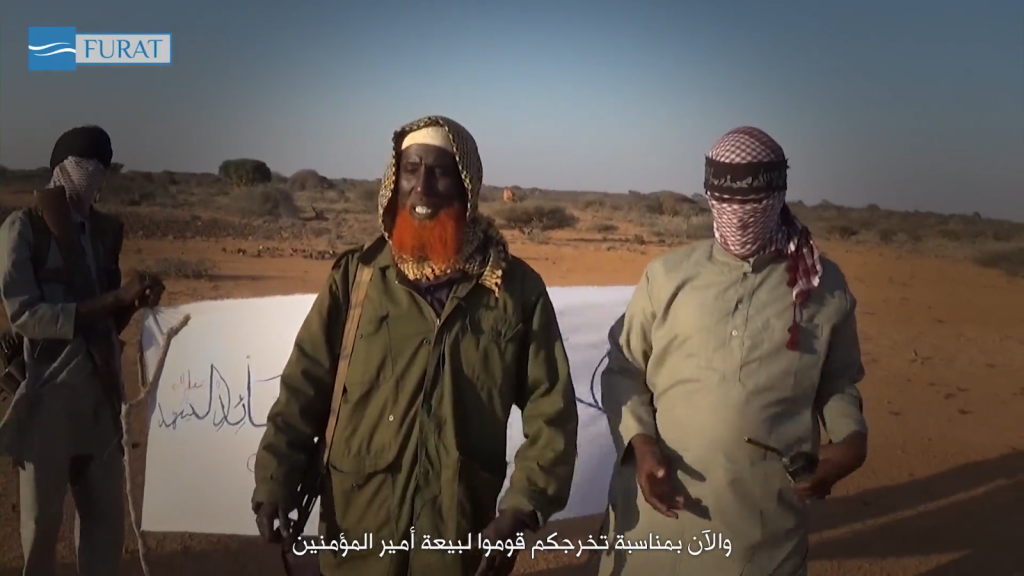
The Islamic State in Somalia (ISS) emerged in October 2015, when former al-Shabaab ideologue Abdul Qadir Mumin pledged allegiance to the Islamic State. Though the pledge has never been formally recognized, the Islamic State in Somalia have increased their operational tempo throughout 2018: according to data from FDD’s Long War Journal, as of July 25, 2018, the Islamic State in Somalia had claimed 67 attacks, though it still does not have the capacity to challenge al-Shabaab for jihadi hegemony.
When it comes to the Islamic State in Somalia’s numbers of fighters, when the group first emerged with Mumin’s breakaway from al-Shabaab in 2015, data reported by FDD’s Long War Journal suggested that it had as few as 20 members. There were estimates that its numbers were fewer than 100 fighters by August 2016, according to the same source. In October 2016, just after it launched its most notable attack— the takeover of the port town of Qandala, which it held from October to December 2016—Voice of America’s Harun Maruf, relying on intelligence provided by a former Puntland Intelligence Agency official, suggested that the Islamic State in Somalia had between 200 and 300 fighters.
After it was dislodged from Qandala, fighter numbers seemingly declined: by December 2016, local observers like Mohamed Olad Hassan estimated that the group had only between 100 and 150 fighters. By June 2017, a defector from Islamic State Somalia told a local news outlet that the group had only around 70 fighters. However, due to an increased recruiting drive—which includes targeting children as young as 10 years old—in addition to its recent spate of attacks as described above, anecdotal evidence suggests that ISS’s numbers are again on the rise, though not drastically. While one Somali journalist, Abdirisak Mohamud Tuuryare, suggested that there were 300 ISS fighters in May 2018,another local Somali journalist put ISS’ numbers at “not more than 100” in July 2018. For his part, Caleb Weiss, who studies the group, suggested between 150 and 200 in July 2018. The authors take a middle estimate of 150.
In video, Somali ISIS members court Al-Shabaab

CNN
Fri May 22, 2015
A recently released propaganda recruitment video by ISIS shows Somali fighters in the group inviting other Somali jihadis to join their ranks.
In the roughly six-minute video, five unmasked men of Somali ethnicity arrive in large, new-looking SUVs. They are carrying weapons and surrounded by heavily armed bodyguards.
Speaking in Arabic under palm trees, the men take turns imploring Somalis and members of the insurgent group Al-Shabaab, whom they refer to as ”truthful mujahedeen” to join their movement to fight the West, and to pledge allegiance to ISIS.
This is the first time ISIS has appealed directly through video to Al-Shabaab to merge with them.
Al-Shabaab, meaning “the youth,” is a Somalia-based insurgent group that formally pledged allegiance to international terror organization al Qaeda in 2012.
However, there has been a strong international effort to counter it, including military action by U.N.- and U.S.-backed African Union forces.
Since 2011, when the militants were forced out of Mogadishu, the capital, the group has been weakened significantly. It has lost territory and revenue from being pushed out of key seaports. One of the most major blows came in 2014 when its leader, Ahmed Godane, was killed in a U.S. drone strike.
However, in what some experts see as desperate attempts to appear formidable, the militants have launched deadly attacks both inside Somalia and neighboring countries, including two massive assaults in Kenya: the killing of 142 students at a university and the 2013 shopping mall attack in Nairobi that left more than 67 dead.
Expert: Merger would be ‘significant ideological victory’
Security expert Ryan Cummings says that ISIS’ desire to merge with Al-Shabaab is part of its international expansion plan.
“Al-Shabaab is the largest jihadi movement in East Africa, and central to the core mandate of ISIS is the unification of the Muslim world, so it would be a significant ideological victory for the group. It would be massive from a public relations perspective, which is central to the Islamic State’s operations,” Cummings told CNN.
“This is all part of the ongoing attempts by the Islamic State to try to coax Shabaab into pledging its allegience. As we know, Al-Shabaab currently serves as an al Qaeda franchise. The issue is obviously that the Islamic State still wants to create the perception that it’s growing and branching out to various parts of the world. The only way that it will be able to achieve this will be to have groups serving as an extension in their various areas of operation,” he added.
ISIS has already merged with several jihadi groups across the continent once loyal to al Qaeda. Its most recent coup was in West Africa, as Boko Haram declared its “bayat,” or pledge, to join ISIS earlier this year. At the time, Boko Haram consisted of roughly 6,000 fighters and controlled up to 20,000 square kilometers (7,700 square miles, roughly the size of Massachusetts) of northeastern Nigeria.
Experts see friction within Al-Shabaab leadership
In most of these countries, the militant groups are seeking to topple the secular governments and to replace them with Islamic caliphates instituting Sharia law. Experts say ISIS supports these domestic ambitions, which Al-Shabaab subscribes to as well.
With a possible merger, experts warn, there’s a risk of more frequent brutal attacks as Al-Shabaab seeks to expand its operational and recruitment reach farther into Kenya, Tanzania and even Uganda.
Al-Shabaab is currently seen as a predominantly Somali militant group, and has been attempting to recruit elsewhere in East Africa. A partnership with ISIS, experts say, will increase its cosmopolitan appeal, which could potentially increase recruitment.
However, sources familiar with Al-Shabaab’s internal affairs say that there is currently friction within the leadership of the group, between those who want to maintain and even increase relationships with global jihad movements, and those who want to stick to their initial domestic mandate.
Tensions rise as al-Shabaab foreign fighters consider supporting Isis

Associated Press
Tue 8 Dec 2015
The defections of two fighters – an American and a US resident – from Somalia’s Islamic extremist rebels highlight tensions within al-Shabaab over whether it should remain affiliated to al-Qaida or switch allegiance to the Islamic State group, according to an al-Shabaab commander.
Foreign fighters are being alienated and feel trapped in Somalia over suspicions that they are plotting to switch allegiance to the Islamic State group fighting in Syria and Iraq, Abu Mohammed, a military commander with al-Shabaab told the Associated Press.
The “ambitions” by some foreign fighters in al-Shabaab to join the Islamic State group had led to them to be isolated within the Somali group and even face death at the hands of their erstwhile comrades-in-arms.
An American who had been fighting with al-Shabaab left the rebels and was arrested by Somalia’s security forces on Monday. Abdimalik Jones, who said he is from San Diego, was arrested in the southern port of Barawe, said African Union spokesman Col Paul Njuguna.
Jones claimed he fled al-Shabaab because of rifts within the group, said an official with Somali security forces who insisted on anonymity because he is not authorized to speak to the press. Jones is missing the index finger of his right hand, said the official.

Separately an American resident, a Minnesota man named Mohamed Abdullahi Hassan who joined al-Shabaab in Somalia more than seven years ago, surrendered to Somalia’s federal government on 6 November, the US State Department said in an email. Hassan was a lawful permanent resident of the US but not an American citizen.
Hassan had been fighting with al-Shabaab but recently went online to urge others to carry out violence on behalf of Isis. He was among those wanted by the FBI for allegedly providing material support to al-Shabaab, and he faces several terrorism charges in the United States.
State department spokeswoman Pooja Jhunjhunwala said Hassan is in the custody of the Somali National Intelligence and Security Agency in Mogadishu. She said the US is discussing the case with the Somali Federal Government, but noted that the US does not have an extradition agreement with Somalia.
In a phone interview Tuesday with Voice of America, Hassan said he has no intention of returning to America.
“Any crimes that I have committed, if there is any, it is done over here in Somalia,” he told Voice of America. “If I am to be going to court, it is going to be in Somalia not in America.”
Hassan, who was speaking from prison, said he wasn’t tied to the Islamic State group. “I am not part of Isis and I have nothing to do with any other group or any other jihadi movement,” he said.
Hassan said he joined al-Shabaab to help defend against the Ethiopian intervention in Somalia, but he left the group in 2013 “because of the oppression that they are doing on the people, the way they are killing people, and the imprisonment of innocent people and the torture without no evidence at all”.
He said that last month, al-Shabaab members raided his home and terrorized his family, Voice of America reported. He said that he escaped, but was later arrested by government forces.
The defections of Hassan and Jones show tensions within al-Shabaab, according to Mohammed.
“Some mujahedeen fighters are now preferring to fall into the enemy’s hands instead of meeting death in the hands of brothers,” said Mohammed, adding that the friction over Isis “is messing everything up here”.
Al-Shabaab’s leadership declared that fighters acting in contravention with the mainstream stand to be aligned with al-Qaida would represent “Bid’ah”, or misguidance, which would lead to them being killed.
Foreign fighters with al-Shabaab would have to give up their desire to join Isis to escape death, said Mohammed.
“They have no choice,” he said by phone from southern Somalia.
Al-Shabab Fighters Loyal to Islamic State Complicate Somalia Security
April 28, 2016
VOA

Members of al-Shabab in Somalia who recently pledged allegiance to Islamic State are moving into the capital, Mogadishu, according to a senior intelligence analyst.
Colonel Abdullahi Ali Maow, a former national intelligence officer who now heads the new Mogadishu-based Somalia Institute for Security Studies, told VOA that some al-Shabab members are fleeing to the capital and to areas near the border with Kenya because they were overpowered in the region of Middle Juba.
Maow said Mogadishu is attractive because, as a city of several million people, it is an easy place to blend in.
This week, Islamic State claimed responsibility for an attack in Somalia when an explosion targeted a convoy of African Union troops outside the capital.
But AMISOM military spokesman Joseph Kibet told VOA that Islamic State may not have been behind that attack.
Al-Shabab, however, did not claim responsibility for that attack, as they often do.
An intelligence official who did not want to be identified by name told VOA that al-Shabab is hostile to former members who have pledged allegiance to Islamic State, creating a rift between the two factions. He predicted there may be instances of violence known to the two groups, but left unexplained to the general public.
Colonel Maow, who told VOA the pro-Islamic State al-Shabab members are coming to Mogadishu, said the government plans to treat them the same way it treats other al-Shabab members. But he said the government is concerned that the Islamic State adherents will gain more followers.
“They may not have power now,” he said, “but it complicates the situation.”
Intelligence Official: Islamic State Growing in Somalia
May 05, 2016
VOA

WASHINGTON —
Pro-Islamic State Somali militants have grown in numbers and are receiving financial and military support from Yemen, a top intelligence official told the VOA Somali Service.
Abdi Hassan Hussein, the former Director of the U.S.-backed Puntland Intelligence Agency (PIA) said when the pro-IS Somali faction was founded in October last year it had about 20-30 men, but has since set up training camps and recruited more fighters. He said the group’s fighters now number between 100-150 fighters. “They have graduated their first units and they have received their military supplies,” he said.
Hussein led PIA until a year ago when he was replaced. His main job was to detect militant threats and plan counter-terrorism operations.
He said Islamic State has welcomed its Somalia branch and has started delivering supplies through their affiliate faction in Yemen.
“They received military supplies from Yemen – weapons, uniform, ISIS sent trainers who inspected their bases, and they have started sending financial support,” he said. “The weapons’ shipment was delivered by sea from Mukallah city in Hadramouth, it has arrived from the Red Sea coast of Somalia in February and March this year.”
Hussein pointed to a recent video posted by the group that he said shows the group received new uniforms. He said there is also evidence that the group has received financial support from Islamic State. “Evidence of financial support can be seen in the area; they are buying supplies, they are buying vehicles, they bought livestock, they invested in the community by delivering water supplies to nearby community affected by the drought,” he said.

Hussein said reports he has received indicate administrations in Somalia have underestimated the threat of the pro-IS group led by former al-Shabab cleric Abdulkadir Mumin. He criticized the Somali government and regional administrations for not taking the threat seriously. He said Islamic State will pose tougher challenge than al-Shabab. “Daesh is more dangerous than al-Shabab. They are known for committing large scale destruction. They have more finance. They have more impact. They declared to start attacks within Somalia, and they readied units to carry out attacks.”
He said the faction now has a base in Al Bari Mountains in Puntland, where it gives training and has erected a flag used by Islamic State militants. He said the base also provides logistics, and has cemented connections with Yemen.
He said opportunity was missed to neutralize the group at early stage. “It would have been better to destroy them when they were 20 or 30 men, before they adapted to the environment; but now the terrorists got used to the climate, they secured access to water wells, routes, and hiding places, “ he said. “Now to defeat them would require the same resources and effort that was placed against al-Shabab.”
The Somali military this week said they destroyed a training camp by pro-IS Somali and foreign militants in Jannaale town area, about 120 kilometers south of the Somali capital, Mogadishu. It followed after Islamic State for the first time claimed credit for an attack against African Union forces just outside Mogadishu last month.
Hussein said the government and African Union troops can’t win against al-Shabab or IS factions militarily, and urged them to confront the groups ideologically. “The youth they are sending are assets, but misguided; they need to be saved from harming the people and harming themselves,” he said.
“They need to be confronted ideologically, they need to be shown different ideology, given an opportunity to leave the group, given protection against prosecution from the government and retaliatory attacks from Al-Shabab if they decide to leave group. We need to create opportunities for the youth,” Hussein said.
ISIS faction raises black flag over Somali port town

CBS News
OCTOBER 27, 2016
QANDALA, Somalia — While the international community has focused on combating the Islamic State of Iraq and Syria (ISIS) in Syria, Yemen, and Iraq, the terror group has steadily been gaining ground in Somalia.
On Wednesday, ISIS captured the ancient port town of Qandala, signaling a new front emerging in the war against the terror group on the strategic Gulf of Aden.
“This is a symbolic victory because this is the first major town that ISIS has captured in Somalia,” said Mo Fatah, a Somalia expert.
In video posted by the group, militants are seen advancing into Qandala, and raising their flag over the East African fishing town.
Militants took over the town early Wednesday to little resistance, overwhelming local police forces.
“Qandala town fell into the hands of Daesh this morning,” Jamac Mohamed Khuurshe, a senior official in Qandala, told Reuters. “Our soldiers were few and so could not fight any longer.”
Daesh is the Arabic term for ISIS.
Up until now, the area had been considered among the safest in Somalia because of its proximity to the major Somalian city of Bosaso, the economic hub of the Puntland region.
“People in the region have been worried about it, asking the international community for support. Almost a million people living in the region want to establish their own security forces to push them out, but they don’t have the funds and resources to combat [ISIS],” Fatah told CBS News.
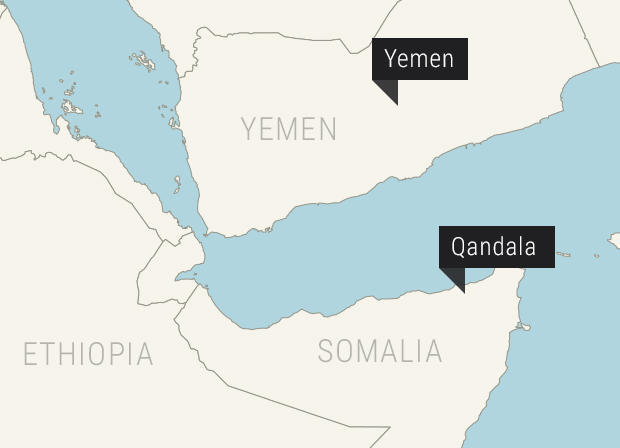
Puntland is a mountainous, semi-autonomous northern state in Somalia. The region is located at the tip of a major shipping lane through the Gulf of Aden, and has been the focus of international efforts to combat piracy.
“Now with ISIS in Yemen, Syria, and Iraq, the fact they hold can hold a major town in this country as well gives them an opportunity. Puntland is harder to attack because of its mountainous nature, it’s not Iraq or Syria, and can provide them a place they can go and group,” Fatah said.
The faction of ISIS in Somalia involved in Wednesday’s attack is reportedly led by Abdiqadir Mumin, a former recruiter and spokesman for al Shabaab.
Al Shabaab, a rival Islamist militant group, has long operated in the region.
The United States designated Mumin a terrorist in August, saying that he “along with around 20 of his followers” had pledged allegiance to ISIS in October 2015.
The force that captured Qandala suggests the organization has grown significantly in the year since. Local media estimates that at least 50 militants were involved in the attack.
Fatah doubts the forces will be able to hold the town permanently, but warns that the capture of Qandala is a sign of the new and growing threat ISIS poses in northern Somalia.
Forces Retake Somali Town Held by Pro-Islamic State Fighters
December 07, 2016
VOA
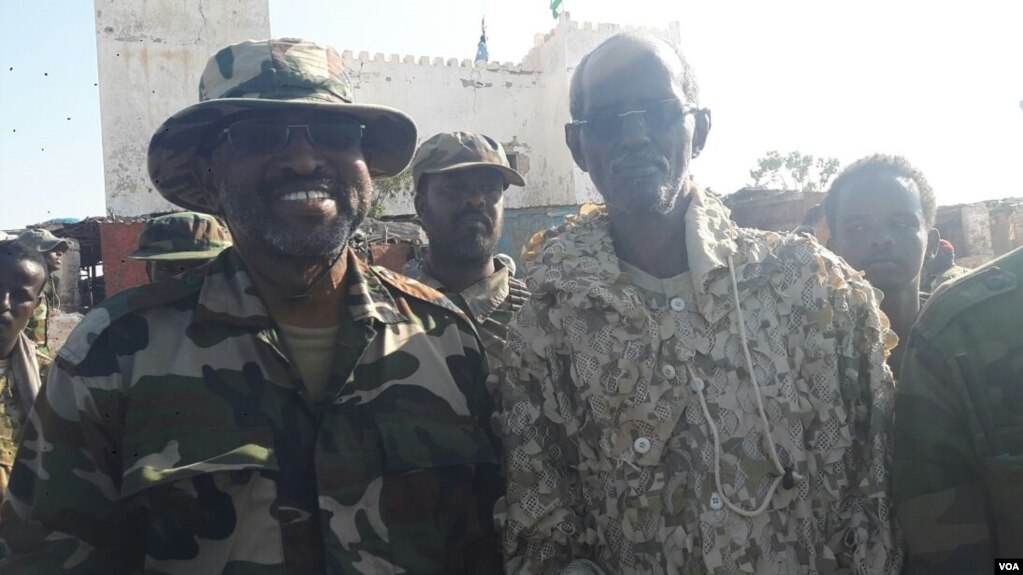
Forces in Somalia’s Puntland region have retaken Qandala, the only town in the country that was controlled by fighters allied with Islamic State.
Fadumo Yasin Jama, a reporter for VOA’s Somali Service, says Puntland troops recaptured the Red Sea coastal town just after 10 a.m. local time Wednesday.
Jama said pro-IS fighters fled Qandala as the attackers entered by land and sea. “We were near the shore of Qandala when the troops entered,” she said. “Puntland forces have been firing guns when they landed on the beach and entered the town but they were not receiving any response.”
The Puntland forces included clan militias, police and regional government soldiers. They reached Qandala after an 11-day trek over rough terrain with narrow roads.
Jama said the troops who arrived by sea seized the old fish factory and the historic headquarters of the district commissioner, built by Italian colonists.
“The troops are entering the homes and other buildings right now, one by one,” she said.
Puntland officials said their forces had two major clashes with the militants on Saturday and Monday. Regional Planning Minister Shire Haji Farah, who led the offensive, told VOA that his forces killed 30 pro-Islamic State fighters and wounded 35 others.
Farah said they seized three vehicles from the militants, including a truck carrying laptops, medicine and items that could be used for explosives.
He said their task now is to help people resettle the town. “We appeal to the people of Qandala who fled to return to the town, to come; we want to tell them that the town is peaceful, the will help them resettle,” Farah said.
Farah said the militants fled to Gurur in the mountainous areas south of Qandala. He said the troops will pursue the militants.
A security source told VOA that 21 militants, among them a senior commander of the pro-IS fighters, Mahad Maoallim, were spotted in Gurur village this morning. The source said the men asked for water and food and then left the village.
The villagers told the security forces that one of the men was wounded. There is no word on the whereabouts of the group’s leader Abdulkadir Mumin.
Residents of Qandala after the militants captured it on October 26. Jama said she did not see any civilians Wednesday, saying “the town was empty”.
“We asked the first troops who entered the town if they saw any human being, they said they have not,” she said.
“The doors of the shops were open. I could see items being sold inside left untouched. Some of the homes were also left open, the items and furniture scattered as if their owners fled the town in a hurry,” she said.
Islamic State has tried to win support in Somalia since 2014 but has lured only a small number of Islamist militants away from the country’s dominant jihadist group, al-Shabab.
Islamic State Claims Attack in Somalia
October 24, 2017
VOA
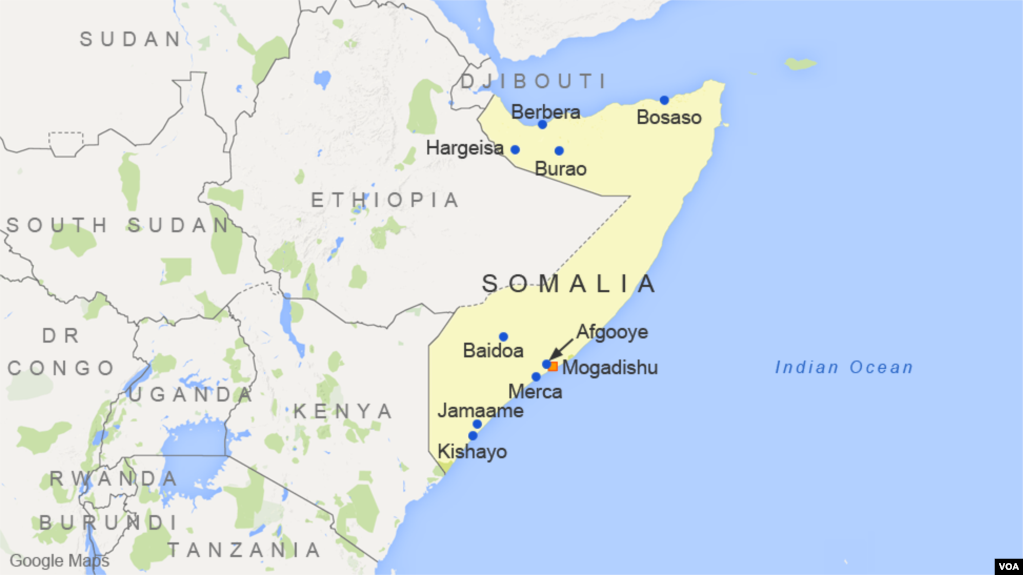
Islamic State militants have claimed responsibility for an explosion in the Somali town of Bosaso on Tuesday, the fourth attack claimed by the group in two years.
Witnesses said a man pushing explosives hidden on a wheelbarrow approached the central police station of the commercial port town. The explosion killed the bomber and injured six others. A second explosion was heard in the same area believed to be from an improvised explosive device but did not cause any casualties, witnesses said.
The attack comes four days after IS militants based in Somalia attacked Injil village in the Bari region, killing two civilians including a child after accusing their father of collaborating with the regional government, relatives said.
IS militants emerged in Somalia after splitting from al-Shabab in October 2015.
The group claimed its biggest attack in late October 2016 when its fighters seized the ancient town of Qandala from Puntland forces and kept control of it for 40 days.
Islamic State militants in Somalia have bases in the eastern Al-Bari Mountains of Puntland and are led by Abdulkadir Mumin, a well-known cleric who was previously a member of al-Shabab’s leadership.
US Targets Islamic State in Northern Somalia
November 03, 2017
VOA

WASHINGTON / PENTAGON / LONDON —
U.S. airstrikes Friday targeted Islamic State fighters in northern Somalia, defense officials told VOA.
U.S. Africa Command (AFRICOM) issued a statement later in the day confirming that the military had killed “several terrorists” in two airstrikes against the terror group.
“We are currently assessing the results,” AFRICOM said.
The chairman of the town of Qandala, Jama Mohamed Qurshe, told VOA Somali that several missiles had hit a base for IS militants at Buqa village, 60 kilometers south of his town in the semiautonomous region of Puntland.
“According to the information we are getting from the ground, six missiles hit the militants’ base in the mountainous area. Local residents and pastoralists were shocked and fled from the area,” Qurshe said.
He said that prior to the strike, residents reporting hearing airplane sounds.
Details of the strike were still not clear — locals said the remote area was accessible only to the militants — but local officials and residents suspected the airstrike targeted the group’s senior leaders and perhaps even its top leader.
The pro-Islamic State faction in northeastern Somalia is led by Sheikh Abdulkadir Mumin, a former al-Shabab cleric who pledged his allegiance to IS leader Abu Bakr al-Baghdadi in 2015. In 2016, the U.S. State Department designated Mumin as a global terrorist.
Since the emergence of the IS faction in October 2015, the militants have claimed responsibility for at least four deadly attacks in Puntland.
In late October 2016, the militants briefly seized Qandala before they were driven out by Puntland’s government.
No cutoff in funding
Meanwhile, the U.S. government denied reports that it was planning to cut funding for the Somali government.
Somali media reports said the U.S. might reduce funding because unnamed Somali officials helped facilitate the October 14 truck bombing in Mogadishu that killed more than 350 people.
There were also reports that linked the alleged cut to an internal State Department finding that the department’s Africa Bureau was failing to ensure that U.S. funding was not diverted to al-Shabab militants.
In an email, a State Department official told VOA that “reports of funding being suspended to the Somali army due to alleged facilitation of the bombings by Somali officials are incorrect. The United States continues to provide extensive support to Somali security forces in their efforts to combat al-Shabab.”
On Wednesday, the Daily Nation, a leading newspaper in Kenya, quoted a report from the State Department’s Office of Inspector General. The report said the Africa Bureau had not established policies and procedures for identifying and mitigating terrorist financing risks for its programs in countries where militant organizations like al-Shabab and Boko Haram operate.
In his email, the State Department official said, “The United States prioritizes transparency and accountability in its partnership with Somalia, echoing one of the top priorities articulated by President [Mohamed Abdullahi] Farmaajo [Mohamed] upon his taking office earlier this year.
“We have communicated conditions for U.S. security assistance to the federal government of Somalia, which includes enhanced measures to ensure proper oversight of our support.”
Also Friday, Somali leaders and the governors of Somali states met for a fourth straight day in Mogadishu, in an effort to agree on implementation of a joint security plan.
The government is said to be preparing for a major offensive against al-Shabab.
Bloody Rivalry Between Al Shabaab and Islamic State in Somalia
hiiraan.com
March 2019
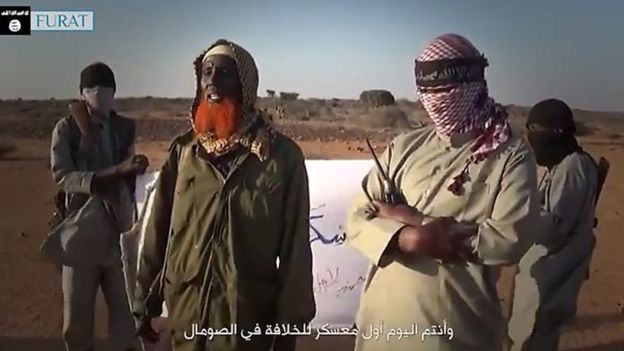
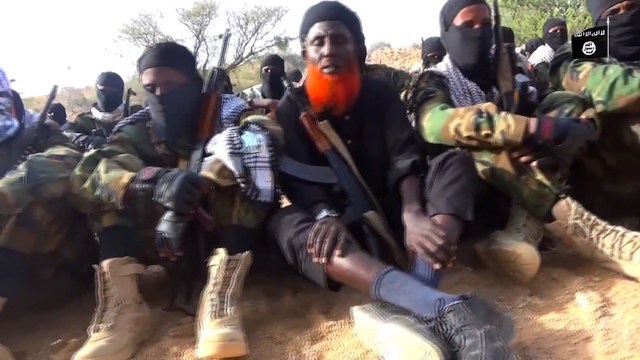

A bloody rivalry has emerged between extremist groups in Somalia as the al-Qaida-linked al-Shabab hunts upstart fighters allied to the Islamic State group, who have begun demanding protection payments from major businesses, officials tell The Associated Press.
The rivalry supports some observers’ suspicions that al-Shabab, now scrambling to defend its monopoly on the mafia-style extortion racket that funds its high-profile attacks, is drifting from its long-declared goal of establishing a strict Islamic state.
The manhunt began in October with the killing of a top leader of the IS-linked group by a suspected al-Shabab death squad in the capital, Mogadishu, according to several Somali intelligence officials, who spoke on condition of anonymity because they were not authorized to speak to the media.
When the body of Mahad Maalin, deputy leader of the IS-affiliated group, was found near a beach in Mogadishu, it set off a hunt for suspected IS sympathizers within al-Shabab’s ranks, officials said. Maalin had been suspected of trying to extend his group’s reach into the capital.
Last month, the Islamic State group’s Al Naba newsletter noted deadly attacks on its fighters in Somalia and warned that “when the time of response comes from the Islamic State, with God’s will, we will be excused.”
The IS-affiliated group in Somalia, largely made up of al-Shabab defectors, first announced its presence in 2016 with attacks in the far north, far from Mogadishu and most al-Shabab strongholds. Though estimated at a few hundred fighters at most, their emergence in one of the world’s most unstable countries has been alarming enough that the U.S. military began targeting it with airstrikes a year ago.
While al-Shabab and its thousands of fighters have hunted down suspected IS sympathizers before, they had not taken the young group’s expansion seriously until now, observers say.
“Al-Shabab miscalculated IS’s organizational capability and ambitions to extend its reach beyond the north, having judged it by its handful of fighters there, and thus missed the bigger picture,” said Mohamed Sheikh Abdi, a Mogadishu-based political analyst.
The revelation by businessmen that IS-linked operatives had begun making extortion demands took al-Shabab’s leadership by surprise, prompting the manhunt that has led to assassinations and the detention of over 50 suspected IS-linked extremists, including foreign fighters, two Somali intelligence officials told AP. One suspected IS-linked fighter from Egypt was shot dead on Nov. 18 in Jilib.
As members of the Islamic State group flee shrinking strongholds in Iraq and Syria, fears have grown that the fighters will find a new and welcome home in parts of Africa.
Alarmed by al-Shabab’s deadly attacks, the IS-linked group has expanded its own assassination campaign. IS’s Amaq news agency, turning its attention to the young affiliate, has released videos showing what it called killings by the group’s death squad.
IS-linked fighters already had claimed responsibility for 50 assassinations in southern Somalia between October 2017 and August 2018, often against federal government officials, according to a report released last month by the United Nations panel of experts monitoring sanctions on the country.
While extortion is the fighters’ latest tactic it is nothing new in Somalia, where al-Shabab has long used death threats and other intimidation to pressure businesses to pay what is called “zakah,” or charity. The money is their main source of funding. “Indeed, al-Shabab is likely generating a significant budgetary surplus,” the U.N. panel of experts said, noting that one of its checkpoints brought in about $10 million a year.
With no strong government to protect them, businessmen often say they have no choice but to pay in exchange for protection.
Among the companies targeted by suspected IS-linked extremists is Somalia’s telecom giant, Hormuud, which intelligence officials say has lost up to 10 employees in attacks in recent weeks. Hormuud officials did not respond to requests for comment.
Businesses worry that the rise of another extremist group seeking cash, as well as a new effort by Somalia’s central government to impose taxes, will bleed them dry.
“At this point, (businesses) are faced with two equally undesirable alternatives,” said Abdisamad Barre, a professor of business management in Mogadishu. “Rejection to the demands for extortion will pave way for attacks by IS, and paying them to evade danger will anger al-Shabab.”
Somali intelligence officials say al-Shabab’s new manhunt is aimed at preventing the IS-linked extremists from expanding their extortion demands into southern Somalia, where al-Shabab levies millions of dollars in taxes per year on travelers and cargo meant for the lucrative port of Kismayo.
Another al-Shabab tactic against its young rival is pressuring religious leaders to issue a fatwa, or edict, declaring the IS group “un-Islamic,” thus legitimizing a war against them, according to sources close to al-Shabab who requested anonymity for fear of reprisal.
Security experts, however, say al-Shabab will find it difficult to unearth IS supporters even within its own ranks.
“That will be a major challenge,” one official said, noting that IS-linked loyalists could be waiting quietly even in al-Shabab’s leadership to make a move. “But that will probably take a long time given al-Shabab’s vigilance.”
Reigniting the Rivalry: The Islamic State in Somalia vs. al-Shabaab

Combating Terrorism Center – Westpoint
APRIL 2019
Abstract: Beginning in 2018, the Islamic State in Somalia, which is believed to only number in the low hundreds of fighters, appears to have significantly expanded its operations across Somalia, albeit from a relatively low base. The group was even, for the first time, recently linked to terrorist activity in the United States and Europe. The Islamic State’s growing assertiveness reignited tensions with its much larger and stronger rival, al Qa`ida’s branch al-Shabaab, with violence again breaking out between the groups. The pushback from al-Shabaab means it is far from clear whether the Islamic State in Somalia will be able to sustain its operational expansion.
Since becoming the dominant jihadi actor in Somalia in 2007, al-Shabaab has effectively maintained its supremacy over jihadi violence across the Horn of Africa. However, beginning in 2015, al-Shabaab, the avowed al-Qa`ida branch in East Africa, has attempted to stave off an aspirational challenger in the form of the Islamic State in Somalia (ISS). Beginning as a disparate clump of pro-Islamic State cells, ISS eventually coalesced into an organized group in October 2015, led by former al-Shabaab commander Abdulqadir Mumin, in Somalia’s northern Puntland region. Despite a tumultuous start, ISS eventually grabbed international headlines when it seized the port city of Qandala a year later. Since then, ISS activity has increased not only in Puntland, but across Somalia as a whole. As this article will outline, ISS, despite its small stature with a few hundred members, has been able to grow and expand its operations in southern Somalia, specifically Mogadishu, and form operational cells in central Somalia.
This expansion has not gone unnoticed by al-Shabaab, as the group has been keen to maintain its monopoly on jihadi violence in the country. The rivalry between al-Shabaab and ISS began as a war of words before devolving into a cavalcade of arrests, executions, assassinations, and clashes between the groups in 2015 at the height of the infighting. These clashes were not openly publicized to jihadis outside Somalia by the groups, with both sides officially keeping tight-lipped about the conflict. But as ISS continues to grow more active inside Somalia, the competition between al-Shabaab and ISS has again reached a boiling point with both sides openly declaring war on each other for the first time in late 2018.
This article draws on metrics based on ISS attack data and independent reporting. It also examines the propaganda released by both ISS and al-Shabaab to examine the evolving rivalry between the groups. This article first provides a brief timeline and synopsis of the infighting between the jihadi groups before 2018. It then examines how the Islamic State has expanded its operations inside Somalia and the group’s emergent links to international terrorism, before examining how the ISS’ growing assertiveness set the stage for a renewal of conflict with al-Shabaab in late 2018. The final section of the article assesses the sustainability of the Islamic State expansion inside Somalia.
The Rivalry Before 2018
To better understand the renewed fighting between ISS and al-Shabaab, it is important to first look at the history of the rivalry between the two. Starting in 2015, propaganda released by the Islamic State began to focus on encouraging members of al-Shabaab to defect and join its cause. In a piece published in this publication in November 2017, this author and researcher Jason Warner identified the earliest known call to al-Shabaab to join the Islamic State’s so-called caliphate as occurring in February 2015, when Islamic State propagandist Hamil al-Bushra penned an article for the Global Front to Support the Islamic State media.
Following the first article, more pieces were released through various outlets before the Islamic State’s media office for its Iraqi “province” of al-Furat released the first video addressed to Somalia in May 2015. Over the course of four days in October 2015, six videos were then released from Syria, Iraq, Yemen, and the Sinai attempting to persuade al-Shabaab to join its cause. Two weeks later, a video was then released from Nigeria, while in January 2016, another was released from Libya.
While al-Shabaab as a whole did not succumb to the Islamic State’s calculated pressure, the jihadi group was able to attract several prominent commanders and disgruntled foot-soldiers within al-Shabaab. As researcher Christopher Anzalone succinctly noted, “Though the Islamic State’s ideology, or aspects of it, are attractive to some members of al-Shabaab, the emergence of such a competitor [in the Islamic State] … provides those disgruntled members [of al-Shabaab] a way to challenge the status quo” of al-Shabaab’s operational culture.
This was not lost on al-Shabaab’s leadership, however, as it began to quickly release internal memos and addresses about the situation via its local radio stations. This includes statements reaffirming its loyalty to al-Qa`ida, as well as calling for the death of anyone who “promoted disunity.” A speech by al-Shabaab’s spokesman Ali Mahmud Rage was also broadcast via al-Shabaab’s Radio al Andalus around this time, which carried the simple point that those who supported the Islamic State will be “burnt in hell.”
While the propaganda war was occurring, al-Shabaab’s internal security service, the Amniyat, was busy arresting, skirmishing with, and sometimes executing known or suspected Islamic State-loyal members in southern Somalia. Dozens of al-Shabaab members were killed or arrested by the Amniyat during this period. Additionally, as Abdulqadir Mumin’s group in Puntland solidified, at least one known clash occurred between it and al-Shabaab’s forces in December 2015.
Following the height of violence in 2015, the tensions between the two groups largely died down with only sporadic incidents occurring in 2016 and 2017. For instance, in November 2016, the Amniyat arrested more pro-Islamic State members in southern Somalia. In March 2017, five Kenyan foreign fighters within al-Shabaab were executed for having switched their allegiances. A month later, two more prominent al-Shabaab commanders were also killed for siding with the Islamic State. The relative calm between the two sides would then last until late 2018 when clashes again flared up. However, the renewed tensions did not occur in a vacuum.
In the aforementioned November 2017 article in this publication by the author and Jason Warner, it was assessed that despite the efforts up until that point by ISS, al-Shabaab maintained its dominance over the jihadi landscape in Somalia and did not face a significant challenge from ISS. While al-Shabaab has since maintained its dominant position, increased ISS activity in the country has caused al-Shabaab to change its calculus to a more aggressive stance against the rival jihadi organization.
Causes of ISS Expansion
Taxes
Starting in 2018, the Islamic State in Somalia appears to have greatly increased its operational tempo. According to a database kept by this author for the Foundation of Defense of Democracies’ Long War Journal, ISS claimed 66 total operations during 2018. While this number is relatively low compared to other theaters in which the Islamic State operates, this was more than the number of claims made by the group in Somalia in 2016 and 2017 combined. To caveat, not all ISS claims can be independently verified, and the Islamic State only rarely produces photographic evidence for its attacks in Somalia. However, independent reporting has also confirmed the expansion in operational tempo of ISS in 2018.
In August 2018, Somali news outlet Garowe Online reported that ISS began collecting taxes on several businesses in Bosaso, utilizing methods of extortion to procure funds. While ISS had already been collecting taxes from locals, this had previously been confined to the rural areas of the Puntland region. Garowe cited Puntland security officials as saying that ISS is able to make $72,000 a month from these taxes. But this was not the first time that ISS’ extortion tactics have been reported in Puntland, as an ISS defector told local intelligence officials this was occurring in the Puntland countryside in 2017. The fact that ISS has been able to run extortion rackets in Bosaso, the commercial hub of Puntland, shows that the jihadi group has become confident enough to operate in urban areas and not just rural ones.
Clan Support
Moreover, clan support has also been beneficial to ISS’ operations and survival in Puntland. According to the Mogadishu-based Hiraal Institute, the Ali Salebaan sub-clan—to which Abdulqadir Mumin (ISS’ emir) belongs—maintains strong support for Mumin’s enterprise. For its part, ISS claims to have members from the various clans and sub-clans of Somalia, thereby giving it the illusion of a wide recruiting base that transcends Somalia’s complex clan dynamics.
Geography of ISS Expansion
But ISS expansion is not restricted to Somalia’s north.g Indeed, ISS was able to make significant inroads in southern Somalia, including Mogadishu, in 2018. Prior to late 2017, ISS claims were primarily confined to Puntland. Starting in earnest in 2018, its violence shifted further south with the majority of its attacks taking place in southern Somalia. Based on data collected by the author, ISS claimed 39 attacks (58 percent of overall claims) in Mogadishu in 2018; this represents a significant increase in activity as the prior two years combined only saw 14 ISS claims in the Somali capital.
This increase was also present in the Mogadishu suburb of Afgoye. In 2018, ISS claimed 12 operations in Afgoye, compared to just eight in the combined previous two years. This increase in attacks in southern Somalia was also noted by the United Nations in a November 2018 report by its Monitoring Group on Somalia and Eritrea. The report noted that between October 2017 and November 2018, ISS had claimed 50 assassinations in Mogadishu. This tracks with the expansion of ISS activity in the area noted above.
The northern Puntland region also witnessed an increase in ISS claims in 2018. ISS claimed 13 operations in Puntland last year, while in the previous two years combined, it only made 12 claims for the region.
ISS has also been able to make some headway in expanding into central Somalia as well. For example, since December 29, 2018, it has claimed eight attacks in the central town of Beledweyne, an area that is a traditional al-Shabaab stronghold. Prior to December, ISS had not claimed any operation within central Somalia, indicating the clear presence of an operational cell in central Somalia. So far in 2019, Beledweyne is actually outpacing more traditional areas of operations for ISS such as the Mogadishu suburb of Afgoye. Since January 1, 2019, ISS has only claimed three operations in Afgoye, while Beledweyne has been the focus in seven claims.
It is unclear at this stage if the creation of an ISS cell in Beledweyne is the result of the shifting of resources from other areas in the face of increased operations against the group, persecution from al-Shabaab or other groups,i or if ISS has been successful in persuading al-Shabaab members to defect in the area. The existence of an active ISS cell in Beledweyne is all but confirmed, however, as it produced the only claim for the December 28, 2018, bombing of a former Somali official in the town.
Much like the expansion in northern Somalia, ISS’ southern expansion has been independently reported. Somali intelligence personnel have arrested several ISS members in Mogadishu. The U.N. Monitoring Group for Somalia has also confirmed the existence of ISS units based in southern Somalia and Mogadishu. For his part, Voice of America reporter Harun Maruf also noted in December 2018 that ISS has increased its activities in southern Somalia.
Expansion Claims in Propaganda
Interestingly, the spread of ISS into southern Somalia has also been claimed in both Islamic State and al-Shabaab propaganda. In the Islamic State’s weekly Al Naba newsletter released on November 15, 2018, the group relayed a series of then-recent events in which several members of its group were killed or arrested by al-Shabaab in southern Somalia. Indeed, these events likely ring true as al-Shabaab itself advertised the execution of an alleged ISS member in southern Somalia just a month prior. Just days before the Al Naba article, it also executed an Egyptian fighter it claimed had defected to ISS. And while not officially claimed by al-Shabaab, the group is widely suspected of being behind the October 2018 execution of Mahad Maalin in Mogadishu, who was then the deputy leader of ISS.
Emergent International Terror Links
Not only did ISS’ operational tempo grow within Somalia in 2018, but it was also linked for the first time to terrorist activity in the West. In December 2018, Italian authorities arrested a Somali citizen in the southern city of Bari on terrorism-related charges after a month-long investigation. According to Italian police, the man was in contact with ISS and discussed potential bomb plots with an ISS individual, but it is unclear if he was acting on any direct orders from any external operations planners from the group. However, this marked the first European terrorism case with any reported links to the Islamic State’s Somali wing.
A month later, three U.S. citizens were arrested in Lansing, Michigan. According to the FBI, all three had professed allegiance to the Islamic State, while one individual was arrested just prior to embarking on a convoluted journey to join the Islamic State in Somalia. While Americans, especially of Somali descent, attempting to join jihadis in Somalia is not new, and indeed Somali-Americans joining the Islamic State elsewhere has been observed, this case shows that ISS now has some international appeal. With the Islamic State losing its last vestiges of territory in Iraq and Syria, it is possible that other individuals looking to join the Islamic State may look to Somalia as a destination to wage jihad.
It is clear that as ISS expanded its operations last year, it grew more confident in its ability to challenge al-Shabaab and spread to new territory. Several of its actions in late 2018 clearly demonstrated this newfound tenacity.
Renewed Conflict
ISS Asserts Itself
ISS’ aspirations to challenge al-Shabaab were made clear in the aforementioned November 15, 2018 Al Naba newsletter. In relaying cases of its members being killed or imprisoned by al-Shabaab, it explicitly warned its rival. “As we record these crimes, we do not do so as a complaint or out of weakness, but to teach people,” the article states, “especially our people in Somalia, what the al Qaeda branch in Somalia has done, because the response from the Islamic State is coming.”
Al-Shabaab did not have to wait long to find out what the response would be. Almost exactly a month later on December 16, the Islamic State claimed its men ambushed a grouping of al-Shabaab’s members near B’ir Mirali, to the southwest of Qandala in the northern Puntland region. It further claimed it killed 14 al-Shabaab fighters, a claim that may have been inflated because the subsequent video released by the Islamic State did not show that many bodies. The warning and subsequent ambush were an indication that as ISS expanded its activities and operations across Somalia, it grew more assured in its ability to openly chastise and target the al-Qa`ida branch.
During the height of the tensions between the two in 2015, neither the Islamic State nor al-Shabaab publicly highlighted the infighting to jihadis outside Somalia. However, ISS’ ambush of al-Shabaab fighters in December 2018 forced al-Shabaab to respond officially, suggesting a shift in how seriously it is taking the Islamic State’s threat.
Al-Shabaab Responds
On December 20, 2018, al-Shabaab released a statement from Ali Mahmud Rage in which he authorized al-Shabaab members to target Islamic State-loyal individuals in Somalia. “The leadership of the Harakat al Mujahideen [al-Shabaab’s full name] orders all the Mujahideen in all the Islamic states [referring to all areas in Somalia] to strongly oppose the prevalence of the disease in the Jihad,” Rage says in his diatribe.
In addition to Rage’s speech, an 18-page treatise was released by al-Shabaab’s general command, which offered the group’s sharpest rebuke of the Islamic State to date. “They violated the Book [meaning the Qur’an] and the Sunnah [customs of Islam] and sought to corrupt the Mujahideen, their religion and their world, and brought them fitna [sedition], they corrupted the religion and the mind of those who followed them, and became a reason for their disobedience,” al-Shabaab’s leadership says of the Islamic State.
Al-Shabaab’s leadership went even further in the treatise by outlining specific crimes committed by the Islamic State, including “spilling the blood of Muslims,” “looting the Muslims’ money,” “spreading lies and rumors,” and “establishing suspicious relationships with infidel regimes.” Under each accusation, al-Shabaab lists several Qur’anic verses or quotes from Islamic authorities that prohibit these things, thus appearing as having the religious and moral high-ground.
In turning to the Islamic State branch in Somalia specifically, al-Shabaab stated “we have examined the situation of their followers in Somalia and we probed their orders and we searched for their doctrine and examined their news and what we found was but lying in the speech and immorality in the rivalry and treachery in covenants and charters.” The leaders also said they tried to be patient with ISS and its members, but the clash in December had changed their calculus. Instead, al-Shabaab’s leaders effectively declared war on ISS by urging “all loyal and honest soldiers [of al-Shabaab] to cure this disease with effective medicine,” as well as “to confront it with force and wisdom.”
A New Phase of the War Begins
Since al-Shabaab’s declaration of war on December 20, 2018, there has been a renewed flurry of clashes and assassinations between the two. On December 23, 2018, Mareeg, a local Somali publication, reported that al-Shabaab members clashed with Islamic State-loyal militants near the town of El Adde in southern Somalia near the Kenyan border. In mid-January 2019, al-Shabaab militants gunned down Yahya Haji Fiile, a pro-Islamic State figure who was once a prominent commander within al-Shabaab.
On January 28, 2019, al-Shabaab targeted ISS members near Mirali, while three days later ISS members struck al-Shabaab members as they were lecturing locals on al-Shabaab in Puntland. In retaliation, al-Shabaab then clashed with ISS fighters in the village of Dhadaar. On February 22, 2019, the clashes continued with the two sides fighting near Af-Garar, also in Puntland. On March 2, 2019, Puntland intelligence officials reportedly claimed that al-Shabaab militants attacked and subsequently took over a major ISS base in the Dasaan area of Puntland.
So far, the open conflict has not had a discernible impact on the Islamic State’s claims inside Somalia.l While it is hard to independently verify, since December 20, 2018, ISS has claimed 30 operations ranging in locations from Bosaso to Beledweyne to Afgooye and Mogadishu. During this time, the Islamic State’s central media also released a propaganda video from Puntland. On a similar but unsurprising note, the renewed war with ISS has also not affected al-Shabaab’s operations elsewhere in the country.
Implications
The Islamic State’s expansion inside Somalia carries significant implications for the overall security of the country. Civilians, especially private enterprises, will likely continue to be extorted if ISS continues to grow its operations. Additionally, Somali personnel will most likely continue to be assassinated by both ISS and al-Shabaab in various population centers across the country.
The renewed infighting between the two also does not bode well for civilian security if these clashes move closer to urban centers. So far, the majority of the clashes have been confined to the Puntland countryside, but this could change if ISS continues to make inroads in southern Somalia. For its part, Puntland security forces have worked to exploit the infighting by targeting jihadi fighters in the mountains near Bosaso.
As with the fighting that occurred in 2015, it is not likely that the Islamic State in Somalia will be able to make any significant gains against al-Shabaab militarily. Moreover, al-Shabaab’s Amniyat has a proven track record of effectively targeting any anti-al-Shabaab dissent within the group. That said, ISS was able to weather al-Shabaab’s targeted campaign back in 2015. It is possible that calculated withdrawals may help ISS survive the renewed onslaught from al-Shabaab. But given al-Shabaab’s harsh ideological critique of the Islamic State and its branch in Somalia, it is unlikely that any grand-scale negotiated settlements will occur between the jihadi groups in the foreseeable future.
There have, however, been a number of small-scale settlements between the two groups. In a December 2018 report to the U.N. Security Council on al-Qa`ida and the Islamic State, U.N. monitors found, via member state information, that ISS and al-Shabaab cooperated on the ground to some degree in Puntland between 2017 and mid-2018. The United Nations noted that the Amniyat wings of both groups had cooperated, while in mid-2018, al-Shabaab released foreign ISS members it had detained in the region. It is likely, however, that the renewal of the conflict between the two groups in late 2018 interrupted such cooperation.
In the November 2017 article by Jason Warner and this author, it was assessed that future clashes could lead to splintering within al-Shabaab between those resistant to the Islamic State and those quietly sympathetic to it. So far, the renewed fighting has not resulted in any clear or public indications of splintering within the al-Qa`ida branch. Additionally, the article noted that increased funding from the Islamic State and recruiting within ISS would make it more competitive to al-Shabaab. While it is currently unknown if more money has flowed into ISS coffers from Islamic State financiers, it is clear that ISS has recruited locally and has even attracted regional and global foreign fighters.
If al-Shabaab is able to strike a major blow at ISS leadership, it is possible the latter group will become more decentralized across the country. While the aforementioned U.N. report notes that Abdulqadir Mumin directed other ISS operatives to establish cells in southern Somalia, the exact nature of the relationship between the core ISS group in Puntland and the cells elsewhere is opaque. It is possible that a disruption between the core group and the other cells could cause a rupture in what unity ISS has across Somalia. In addition, barring missteps from al-Shabaab, such as moves that would harm its standing among the local clans or severe military blunders, the al-Qa`ida branch will likely continue to have the upper hand in its war with ISS.
Since the Islamic State lost its last major Syrian holdout of Baghuz in March 2019, it is important to remember that its branches elsewhere in the world are continuing its fight. Indeed, the loss of physical territory in Iraq and Syria, the longtime center of the Islamic State’s operations, has so far not impacted ISS activities in Somalia. As claims relating to Somalia are still being released by Amaq and the Islamic State’s central media apparatus, communication with its Somali wing appears intact.
The Islamic State’s expansion inside Somalia in 2018 presents some important implications for overall Somali security, especially as the dominant jihadi actor in Somalia, al-Shabaab, has renewed its conflict with ISS by declaring war on it late last year. But given ISS’ small stature in the country and al-Shabaab’s track record of dealing with any potential challenger, the Islamic State’s growing operations inside Somalia may soon stall.
US killed No. 2 leader of ISIS-Somalia, officials say
Airforce Times
Apr 15, 2019
:quality(70)/cloudfront-us-east-1.images.arcpublishing.com/archetype/4H5Z3NVFERCKTJ4WELDEEFMLHI.jpg)
U.S. Africa Command says it killed ISIS-Somalia’s deputy commander. (Senior Airman Christian Clausen/Air Force)
An American airstrike in northeastern Somalia has killed the deputy leader of the Islamic State group in the country, U.S. officials said Monday.
Abdulhakim Dhuqub, who was responsible for the extremist group’s daily operations, attack planning and resource procurement, was killed in the vicinity of Xiriiro, in the Bari region, on Sunday.
The U.S. military has been supporting the government of Somalia as it increases the competency of its security forces and pushes back against extremist groups in the country.
U.S. Africa Command said that precision airstrikes support Somali security forces and allow time and space for governance to grow in the country.
“We continue to work with our Somali partners to keep pressure on the al-Shabab and ISIS-Somalia terror networks,” said Marine Corps Maj. Gen. Gregg Olson, U.S. Africa Command director of operations. “When it supports the strategy, we use precision airstrikes to target those who plan and carry out the violent extremist activities that put Somalis at risk.”
The airstrikes help to create “organizational confusion within the terrorist networks in Somalia,” according to Air Force Col. Chris Karns, an AFRICOM spokesman.
“By consistently placing pressure on the terror networks, it keeps them off balance and reflects the federal government of Somalia’s commitment to enhancing stability and security for the Somali people,” he told Air Force Times. “Various levels of leadership within the terror networks are effectively being targeted and removed from doing further harm to innocent Somalis.”
The strike occurred in an autonomous region of northern Somalia known as Puntland. Most airstrikes have taken place in the southern part of the country. ISIS-Somalia is primarily active in Puntland and is estimated to have roughly 300 members.
ISIS-Somalia is a splinter group of al-Shabab, a group the U.S. says is aligned with al-Qaida and that is also active in Somalia.
At this time, AFRICOM is assessing that the airstrike killed only Dhuqub and destroyed one vehicle.
“Currently, we assess no civilians were injured or killed as a result of this airstrike,” officials said in a statement. “Our process and procedures allow for additional information to inform post-strike analysis.”
IS Followers in Syria, Iraq Want Evacuation to Somalia
June 21, 2019
VOA
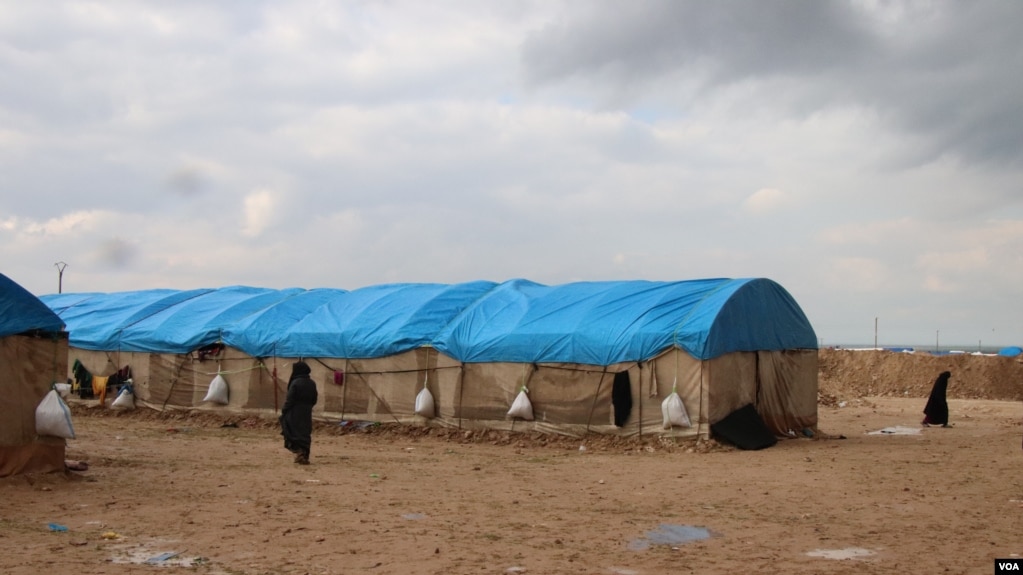
Dozens of European citizens of Somali origin who joined the Islamic State terror group in Syria and Iraq want to go to Somalia due to European countries’ reluctance to take them back.
Through their parents, the so-called Islamic State brides and their children have urged the Somali government to take them in.
VOA Somali service’s Investigative Dossier program has obtained the list of 23 women and 34 children who are now being held at al-Hol camp in northern Syria.
The relatives say the IS brides have expressed “regret” and accept they made a “mistake” in leaving Europe to travel to Syria.
Some of the women have lost their European citizenship. Nasra Abdullahi Abukar is one of them. She left London’s Lewisham Borough on June 3, 2014 and travelled to Syria. In October 2017 the British government revoked her citizenship.
Her mother, Kaha Gure Hassan, says her daughter was born in Somalia and wants to go there to live with her father.
“I appeal to the (Somali) president, Mohamed Abdullahi Farmajo, and Prime Minister Hassan Ali Khaire and the Somali people to get those children returned,” Hassan says. “If they rescue, we will take responsibility for her.”
‘She was groomed’
Hassan says her daughter was not a religious person.
“She used to wear trousers and was not particularly connected to a mosque,” she told Investigative Dossier. “She was groomed [recruited] through the internet.”
Seven days after leaving London, Abukar called her mother and told her she went to Syria to “help the women and children” of Syria.
Hassan says within a year her daughter “regretted” the move and wanted to return to Britain.
“My daughter was not a free person, she was afraid when speaking on the phone,” Hassan said.
The mother of five is now appealing to the Somali government to take her to Somalia where Abukar’s father lives.
Somali German family
On September 9, 2014, a family of four caught a flight from Frankfurt, Germany to Turkey. Two sisters, their brother and his pregnant wife flew to Istanbul and then proceeded to Syria.
Their father, who lives near the town of Mainz, was in Denmark attending a wedding when they traveled.
His son called him three days later from Turkey and assured him they would return, but the father was not sure he was telling the truth.
“I plead with him to at least return the children,” says the father, who did not want to be named. By “children” he means the two daughters who were 14 and 18 at the time. Their brother was 23.
Within six months, the two sisters married jihadists, and their brother was killed.
The younger daughter, who is now 22, has married three jihadists in all – two Somalis and an Eritrean. All three were killed in Syria’s war. She had a child with the Eritrean jihadist and twins with her last husband. The twins died shortly after birth.
The two in-law families from Germany and Denmark now want the widows and orphans rescued from the refugee camps.
“These were just housewives, they are destitute, sick due to lack of health support,” says the Somali-German father. He says his younger daughter recently had anemia and was ill for a week.
“They were not participating in fighting,” he said. “They are desperate to be rescued; nothing else is in their mind. They were brainwashed.”
Traveler from Sweden
Ayni is another IS bride who lost two husbands in the war in Syria. She has arrived in the al-Hol refugee camp after fleeing from the town of Baghuz in March this year following heavy bombing.
Ayni traveled with a group of girls from Sweden in May 2014. She was preparing to get married when a man changed her mind and told her she is marrying someone who is not very religious, according to her mother Saido.
He not only changed her mind about marriage but convinced her to “migrate” to Syria. The two married in Syria and had two children before he was killed in a bombing in October 2017.
Months later she married again and had a third child but her new husband was wounded and captured by allied forces.
“Their survival depended on marrying men as a safety guarantor,” says Saido.
Saido says her daughter tried to escape the group but found no safe way out. She alleges Kurdish forces raid and confiscate mobile phones and money from the women. She says her grandchildren are malnourished.
“Who are these women?”
Somali government officials say they have received the list of Islamic State brides and their children in al-Hol camp, but have not yet made a decision on whether to make an offer to them.
Somalia’s ambassador to the European Union, Ali Said Faqi, who has been in touch with the families says the Somali government is investigating the situation.
“We are investigating, we need a full information,” he said. “Who are these women? There are Somali men [in Syria] who had children with foreign women, they want their children to come here too. This is complex, it needs careful consideration.”
Former intelligence officer Colonel Abdullahi Ali Maow says the Somali government should exercise “caution” and make sure they do not get released to the community until they are thoroughly rehabilitated.
But Ambassador Faqi sees a way out for them if they are sincere about renouncing their jihadist ideology.
“If someone with a terrorist organization renounces the government welcomes them, at this time; they will fall under this category,” he says.
Under Pressure, IS Militants in Somalia Look to Ethiopia
August 19, 2019
VOA
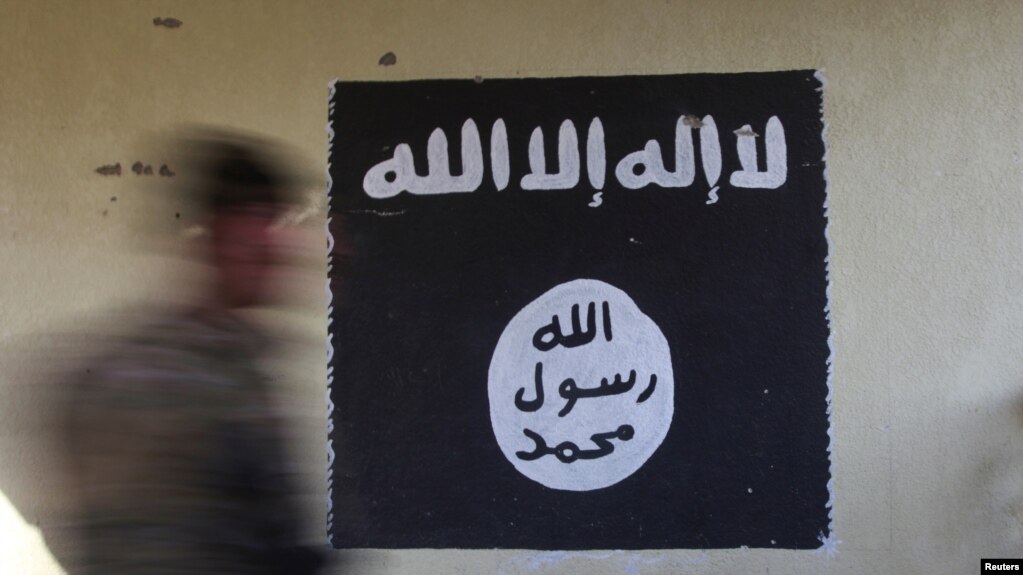
Islamic State militants in Somalia say they will release jihadist materials in Amharic — a step unmistakably aimed at winning recruits in restive, neighboring Ethiopia.
The announcement came in the form of a three-minute video released last month by pro-Islamic State sites and endorsed by the official IS media. The video posted the words to one of Islamic State’s best-known chants in Amharic and promised IS will release more materials in the language, one of the two most-spoken tongues in Ethiopia.
Matt Bryden, an Africa analyst with Kenya-based Sahan Research, believes Islamic State — also known as ISIS — is reaching out to Ethiopia’s Muslim community in an attempt to take advantage of ongoing ethnic and political unrest in Africa’s second most populous nation.

“I think ISIS sees in Ethiopia a potential opportunity. We know the group has been expanding its influences and its activities across Africa quite aggressively — so far with small results in much of the continent but they are persisting,” Bryden told VOA’s Somali service.
He says Ethiopia’s unrest may be worsening despite political reforms enacted by Prime Minster Abiy Ahmed, including the release of thousands of political prisoners and the signing of a peace treaty with longtime foe Eritrea.
“There are many groups that are disaffected and disgruntled by the way the transition is unfolding,” Bryden said. “Where there are communities with grievances, where violence is becoming increasingly the norm, there are opportunities for the extremist groups to recruit, to attract followers and perhaps to establish presence, and I would expect ISIS is trying to do all of those things.”
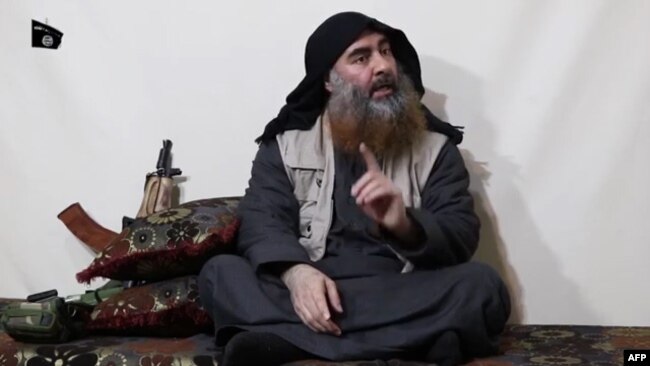
Pro-Islamic State militants emerged in Somalia in October 2015 after a small group of fighters from militant group al-Shabab broke away and pledged allegiance to IS emir Abu Bakr Al-Baghdadi.
Since then, the group has maintained a presence in northeast Somalia and around Mogadishu, even while facing a relentless offensive from both al-Shabab and the Somali government.
Experts say the Amharic video indicates that Islamic State in Somalia has members from Ethiopia. In December 2017, IS Somalia released a video featuring a jihadist from Ethiopia speaking in Amharic. IS identified the jihadist as Abu Zubayr Al-Habash. It was not clear what his position was.
This year, IS issued another video announcing that Al-Habash has died, without indicating the cause of death.
A former IS Somalia member who spoke exclusively to VOA Somali says the group has about eight Ethiopians among its estimated 300 members.
The Ethiopian prime minister’s office has not responded to multiple requests for comment.
US strikes ISIS fighters in Somalia
Airforce Times
Oct 25, 2019
:quality(70)/cloudfront-us-east-1.images.arcpublishing.com/archetype/AAQCVMPBGJHJ3PBONS65RBKLNU.jpg)
Members of Islamic State in Somalia clash with al-Shabab fighters in the northern Puntland region of the country in December 2018. The U.S. has been supporting Somalia government forces with airstrikes against both extremist groups. (Amaq video via CTC at West Point).
U.S. forces conducted an airstrike Friday against ISIS fighters in the Golis Mountains of northern Somalia, according to US military officials.
Officials with U.S. Africa Command assess the airstrike killed three terrorists.
“The Golis Mountains are a known area for terrorist activity,” AFRICOM said in a news release. “Precision airstrikes such as these support Somali security forces efforts to protect the Somali people from terrorists and support long-term security in the region.”
Somalia remains a volatile place, and airstrikes in the country are up slightly in 2019. AFRICOM carried out 55 airstrikes in 2019 against against al-Shabab and ISIS-Somalia militants, compared to 47 such strikes in 2018, according to data provided by AFRICOM. Only eight of the strikes this year targeted ISIS fighters in Somalia.
:quality(70)/cloudfront-us-east-1.images.arcpublishing.com/archetype/6BI6URKFH5H6HITETJVGSOX7DM.jpg)
Between Sept. 30 and Oct. 1. a couple of U.S. airstrikes hit the Islamic extremist group al-Shabab following a brazen attack on a U.S. outpost believed to house American special operators and a Somali commando force known as Danab — a Somali term for lightning.
Lt. Cmdr. Desiree Frame, a spokeswoman for AFRICOM, told Military Times in September that there were 650 to 800 Defense Department personnel in Somalia. Those figures include civilian and military personnel.
ISIS hasn’t made huge waves in Somalia. Officials with AFRICOM assess the terror group only numbers between 100 and 300 fighters. Shabab makes up the core of the insurgency plaguing much of rural Somalia.
Shabab is estimated to have between 5,000 to 7,000 fighters and controls 20 percent of Somalia, Frame told Military Times. A recent UN report detailed that Shabab fighters are adapting to sustained airstrikes from U.S. forces by operating in urban areas.
US Airstrike Hits Pro-Islamic State Militants in Somalia
July 22, 2020
VOA
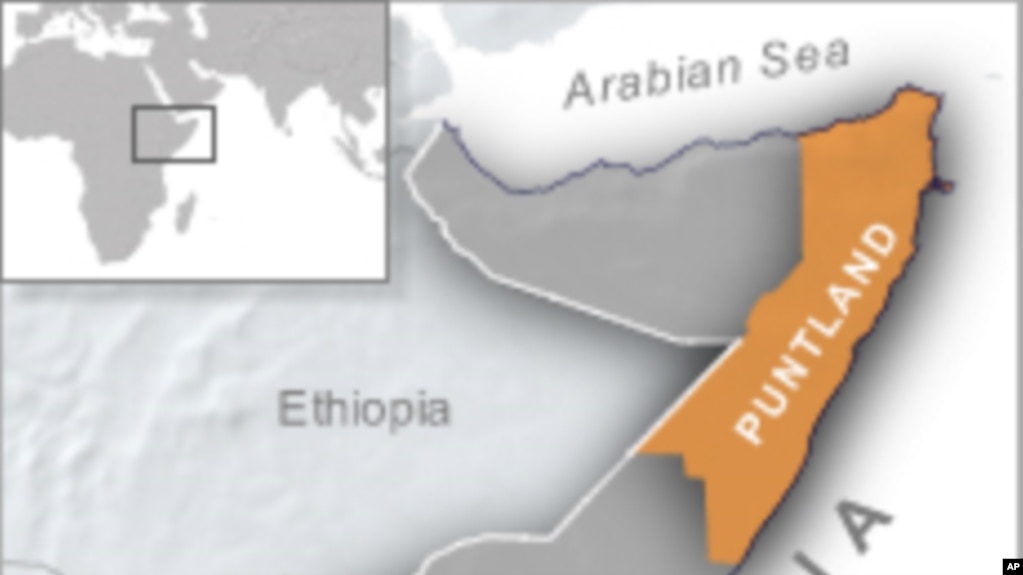
The U.S. military says it conducted an airstrike in Somalia’s Puntland region that killed seven pro-Islamic state militants.
VOA’s Somali service initially reported the airstrike on Tuesday. Local officials and witnesses told VOA that Puntland regional forces carried out a ground operation against the militants in Turmasale and Amayra, mountainous hideouts near the village of Timirshe, 140 kilometers southeast of Bosaso.
A statement Wednesday from the U.S. Africa Command said the airstrike was in response to an attack on partner forces by the militants.
“We continue to apply pressure on terrorist groups and assist our Somali partners in disrupting their operations,” said U.S. Army Brig. Gen. Miguel Castellanos, deputy director of operations, AFRICOM. “We continue our support to rid Somalia of the likes of ISIS and al-Shabaab.”
AFRICOM said it assesses no civilians were injured or killed as a result of this latest airstrike. This was the United States’ 42nd airstrike of the year in Somalia, and the first targeting pro-ISIS forces.
Officials in Puntland issued their own statement, saying they killed 20 ISIS militants during 48-hour operation in the eastern parts of Bari region. Puntland says senior local militants and one senior foreign fighter were among those killed in the operation.
The statement did not identify the foreign fighters killed in the operation but say he was a trainer and a liaison between ISIS in Somalia and ISIS fighters in other parts of the world.
Puntland says the targeted foreign fighter has been in Somalia since 2014. Puntland also said their forces destroyed a storage for weapons, explosive materials and foods.
New Islamic State Somalia Video Shows Weapons Capacity

Militant Wire
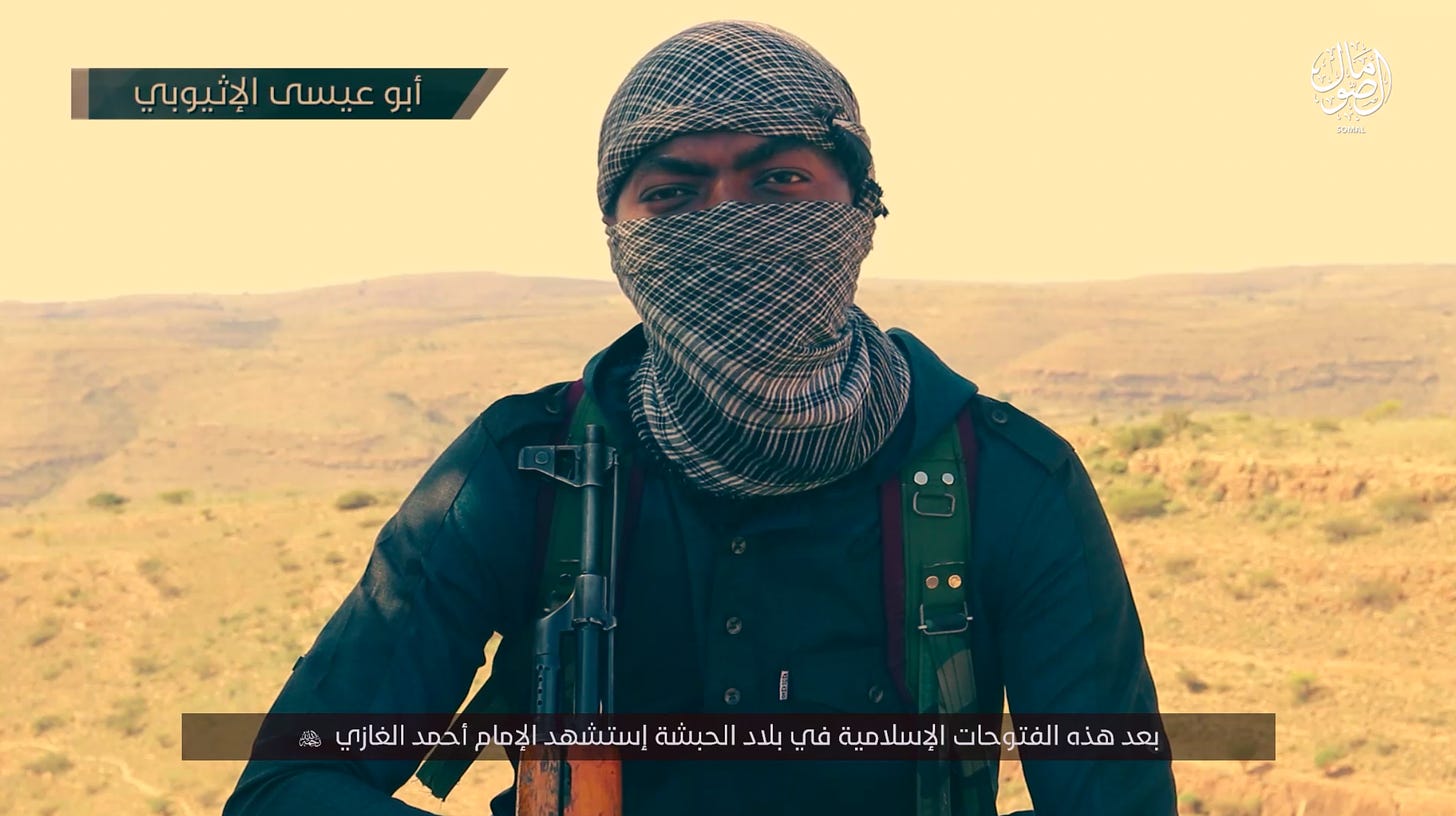
In the latest Islamic State (IS) weekly newsletter, al-Naba (issue 349), a rare announcement was made about an upcoming official video about IS in Somalia. According to jihadism researcher Daniele Garofalo, “this is the second time that the release of a video has been announced first in [al-Naba] and not through its channels.” The first was a recent video production on Islamic State fighters in Iraq.

The Islamic State has been formally operating in Somalia since 2015, and IS central leadership and media are continuing their efforts to promote the group and bolster its profile. The video was released on July 30, is about 25 minutes long, and is in Arabic and Amharic.
Garofalo notes “the importance IS gives to Ethiopia, with the use of Amharic, the historical comparison between Somali Muslims and the Christians of Abyssinia, and the use of Ethiopian speakers/fighters.” In terms of context, he says “this is interesting because in recent weeks its rival al-Shabaab has often attacked Ethiopian forces and crossed the artificial Somalia-Ethiopia border.” Garofalo adds that the Islamic State’s production of “such a long and well-crafted video is a sign of significant investment on the part of IS Central” and IS Somalia leader Abdulaqadir Mumin “has the experience and skills to grow them, and Somalia offers great opportunities.”

Weapons Analysis
Despite its ambitions, the Islamic State in Somalia is still fairly limited in terms of its weapons capacity and offensive capabilities. In the training footage included in the video, the combatants can be seen using very basic and common weapons.
The vast majority of fighters are shown using the Type 56 and Type 56-1 assault rifle, which are basically Chinese clones of AKM and AKMS rifles and are extremely common in the region.
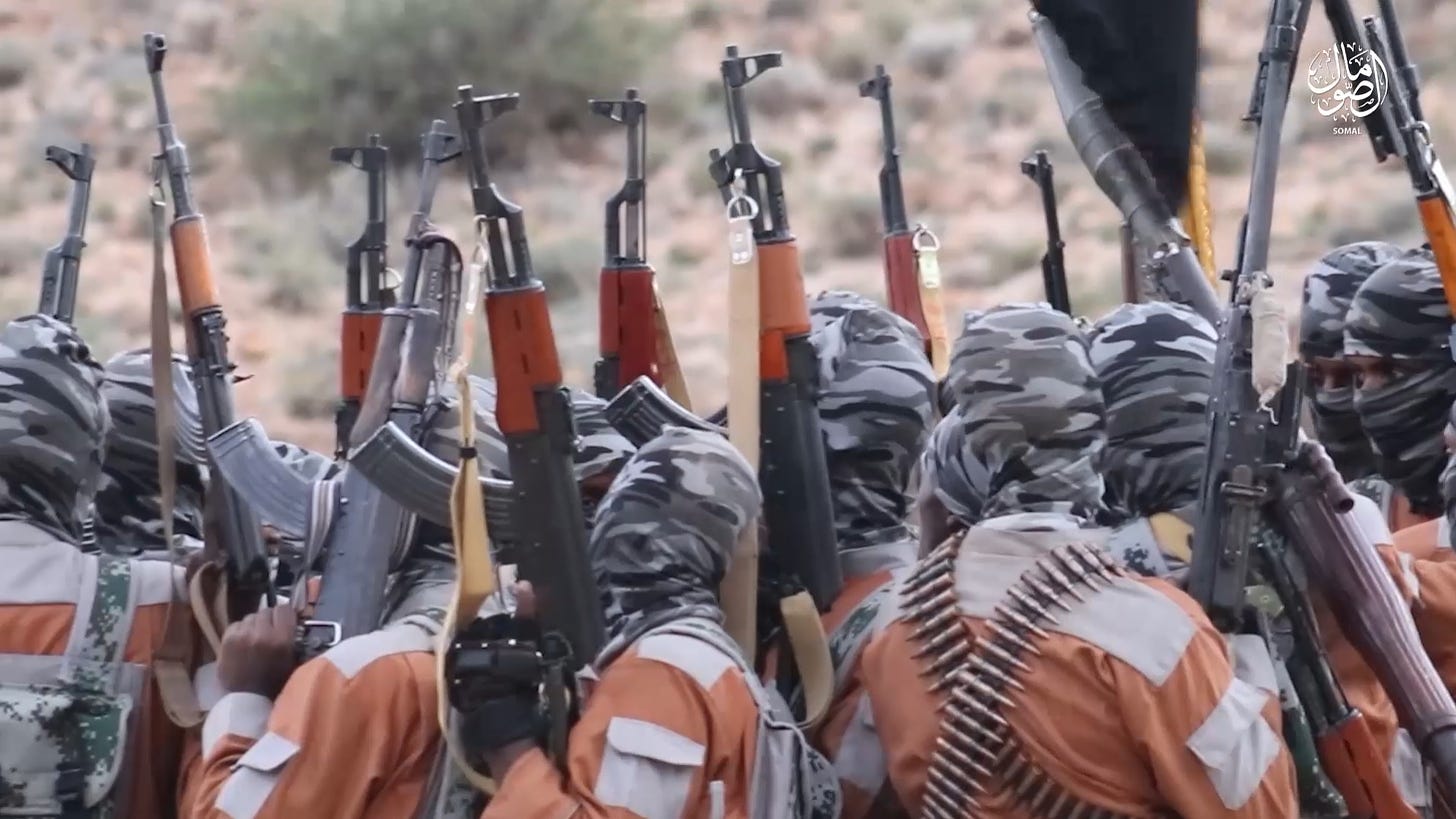
In addition to these weapons, the militants also appear to have the Type 69 RPG Launcher and an early model PK general-purpose machine gun.
Below, an RPG launcher is loaded with a PG-7VM or PG-7VS projectile.
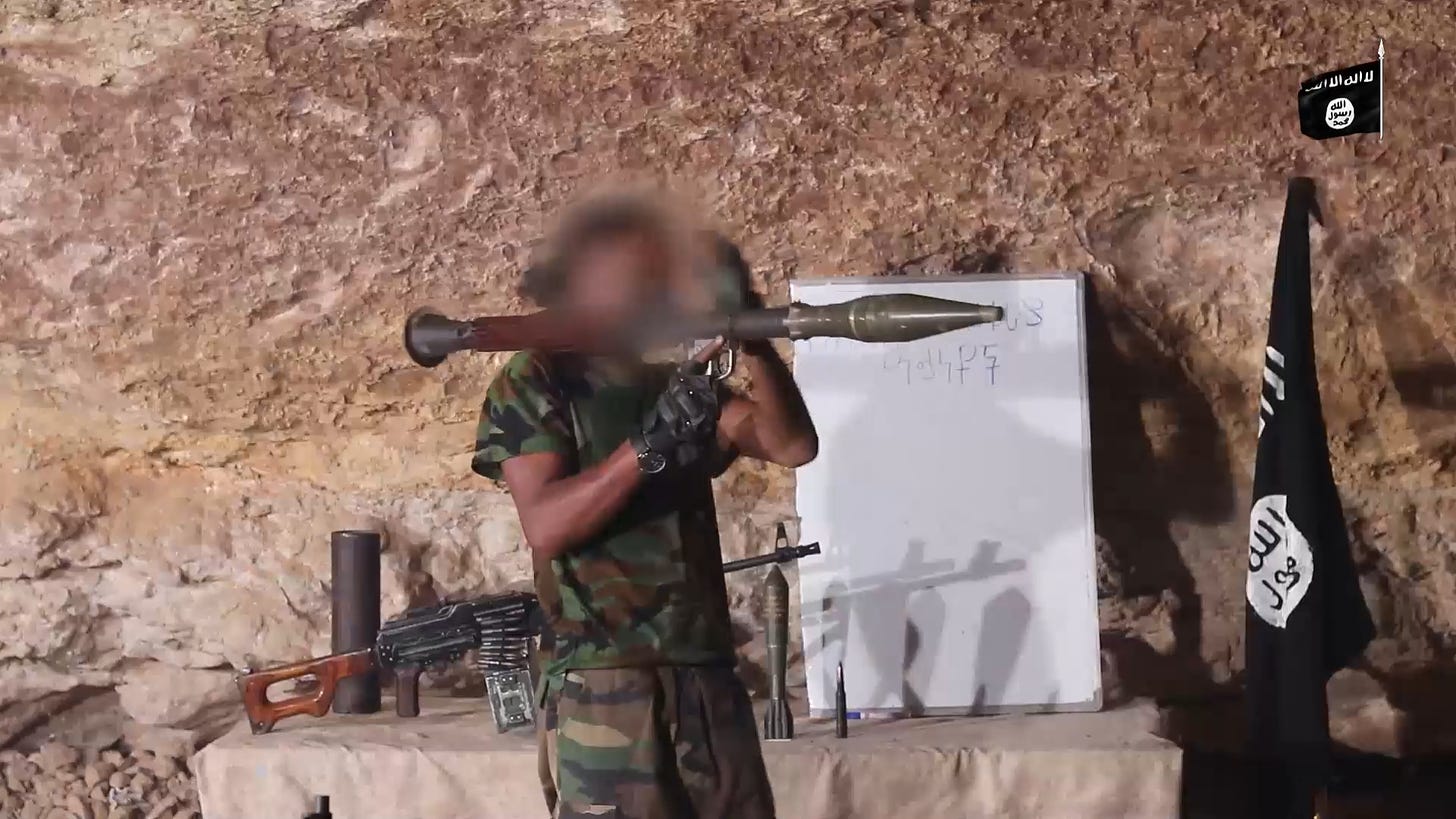
The video also shows the Islamic State’s recruitment process in Somalia.
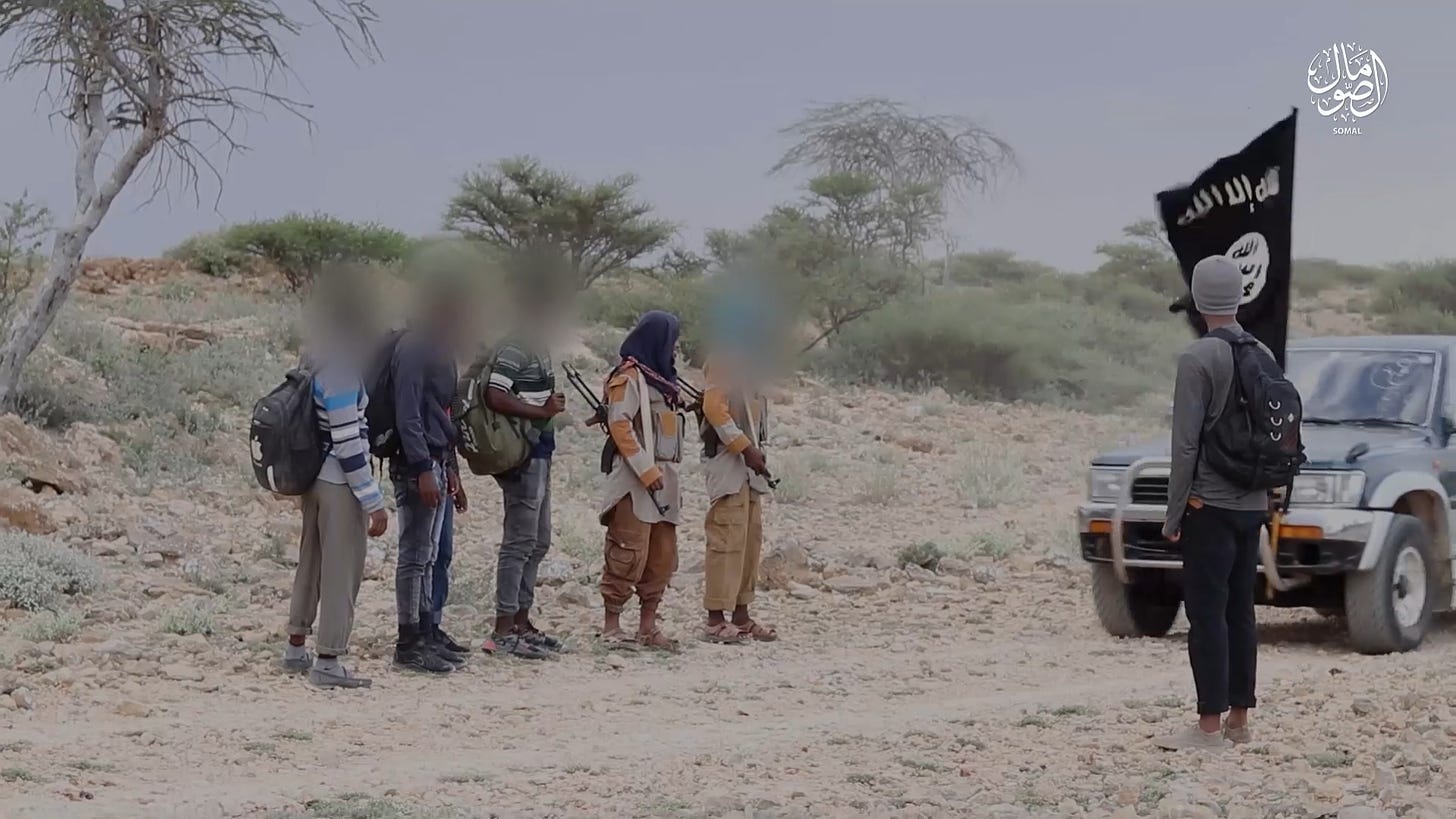

As seen in the photos below, militants are also making a political statement by shooting at pictures of US President Joe Biden and Ethiopian Prime Minister Abiy Ahmed during their training.
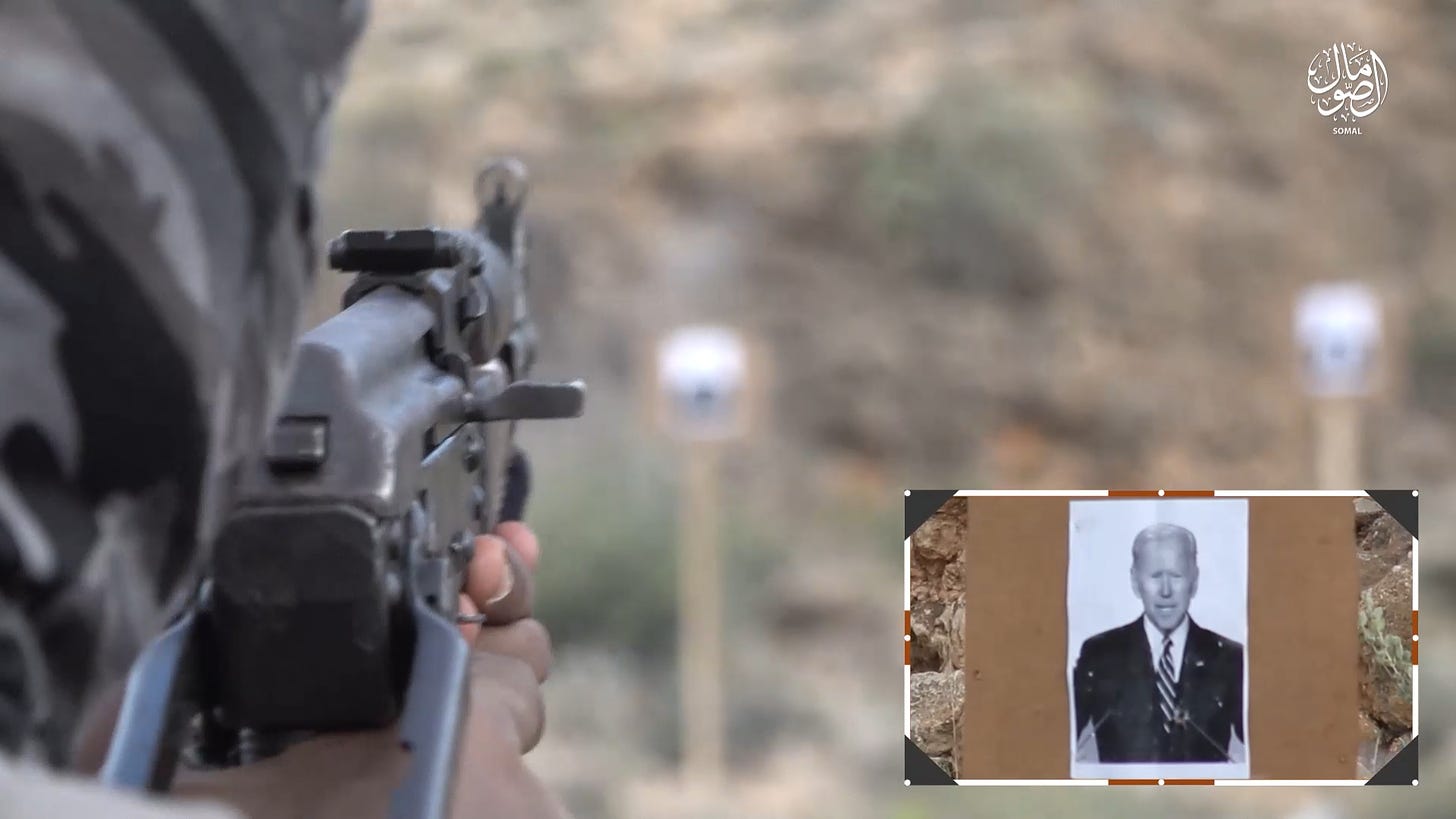

When assessing the displayed weapons capacity of the Islamic State in Somalia, the group’s hardware is not comparable to that belonging to the Al-Qaeda branch Al-Shabaab, which has the largest and most effective arsenal in the region.
The Islamic State’s armament contains fewer weapons than that of Al-Shabaab, and they have much less weapon variety. This, however, is to be expected as Al-Shabaab has a longer history in the region and is a much larger force than IS’s Somalia branch.
2 Islamic State Militants Executed in Mogadishu
October 26, 2022
VOA
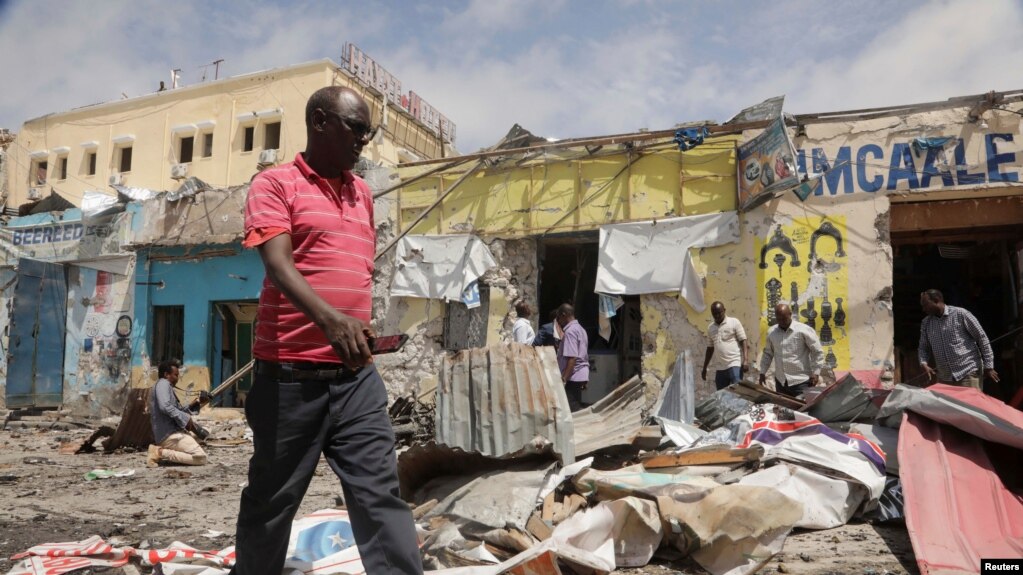
MOGADISHU, SOMALIA —
Somali officials on Wednesday executed two Islamic State militants convicted for carrying out assassinations on behalf of the al-Shabab terrorist group, marking the second execution of Islamist militants in a week. The executions are part of the Somali government’s all-out war on the militants.
The two men went before a firing squad at Mogadishu’s General Kahiye Police Academy after a military appellate court upheld a lower court ruling to execute the convicted militants.
According to court papers, Aden Mohamed Ali Mohamud first joined Al-Shabab in 2010 but later defected to ISIS in 2015, while Mohamed Ali Mohamed Farah joined ISIS after watching the group’s propaganda via encrypted messages on the social media app Telegram.
Military prosecutor General Abdullahi Kamey told the court that the two were involved in a spate of killings of civilians and government officials in central Somalia and the capital Mogadishu.
Professor Abdiwahab Abdisamad, director of the Institute for Horn of Africa Strategic Studies, told VOA the executions were the right step for Somalia’s national security.
“Both al-Shabab and ISIS are enemy of Somali state,” Abdisamad said. “The government must protect the lives and the property of the people of Somalia. So, if any one of them committed a crime against the people of Somalia, government must bring them to book so that they must face the music. So what the government is doing right now, in fact, it’s a commendable job, it’s a good job well done because that’s how things are. That’s any government in the world that in fact will improve the security of the country.”
Wednesday’s executions come just days after the execution of two other convicted al-Shabab militants, all part of an ongoing military operations throughout central regions of the country, where some clans have contributed militias to fight alongside government forces.
Somali government officials on Wednesday said that security forces recently killed 17 al-Shabab members in the Middle Shabelle region.
Abdisamad says that while al-Shabab is facing intense pressure as a result of the operations, the group remains intact and is not likely to suffer.
“Right now there is a defection with al-Shabab, but they are a resilient group,” said Abdisamad. “They are going to retreat, re-strategize their actions and operations in Somalia.”
Abdi Hussein, a security analyst at the Somali Institute for Security Studies, said that, although today’s executions in Mogadishu send a message to al-Shabab and others intending to destabilize the region, reprisals may be imminent.
“The group will exert pressure on towns by increasing attacks and assassinations,” said Hussein. “Therefore, the government should get ready to foil many different types of attacks against the towns including assassinations, VBIED, IEDs on the roadside attacks.”
In its most recent attack, al-Shabab fighters killed at least nine people Sunday at a hotel in the southern coastal city of Kismayo.
Designation of ISIS-Somalia Weapons Trafficking Network

US DEPARTMENT OF STATE
NOVEMBER 1, 2022
The United States has designated an Islamic State in Iraq and Syria (ISIS)-Somalia network of weapons traffickers, their associates, and an affiliated business for facilitating weapons transfers to the terrorist group, as well as Osama Abdelmongy Abdalla Bakr, an ISIS supporter in Brazil. In 2016, senior ISIS leaders directed Bakr to obtain weapons and military equipment for the terrorist group.
The ISIS-Somalia network operates primarily between Yemen and Somalia and has ties to other terrorist groups, including al-Qa’ida in the Arabian Peninsula and al-Shabaab. Many of the relevant individuals are also involved in other illegal activities, including piracy and environmental crimes, demonstrating their integration with illicit networks operating in the region.
The Department of State designated ISIS-Somalia on February 27, 2018, as well as Abdiqadr Mumin, the leader of ISIS-Somalia, on August 11, 2016, as Specially Designated Global Terrorists pursuant to Executive Order 13224. ISIS has increasingly sought to generate revenue in East Africa. ISIS-Somalia, which continues to conduct terrorist attacks against civilians, generates much of its funding by extorting local communities for funding and recruits. The group punishes, intimidates, and assassinates Somali businessmen and civilians who do not support it financially or provide supplies.
US Targets Smugglers Supplying Islamic State in Somalia
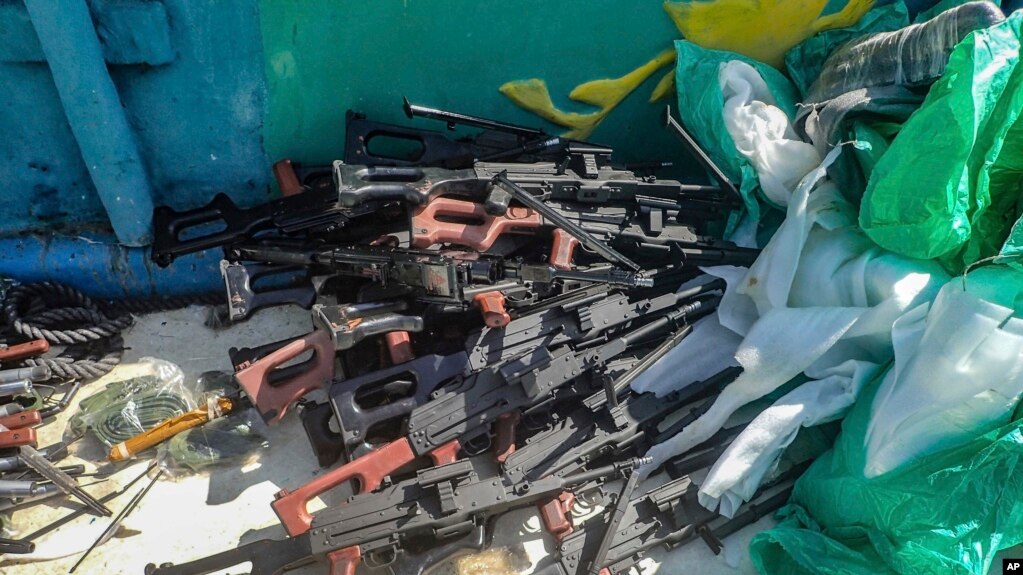
VOA
November 01, 2022
The United States is trying to curb the flow of weapons to the Islamic State terror group’s affiliate in Somalia, taking aim at a smuggling operation that is also helping to arm its al-Qaida-linked rival, al-Shabab, with weapons from Iran.
The U.S. Treasury Department Tuesday announced sanctions against eight individuals and one company all involved in the yearslong effort to smuggle millions of dollars of weapons between Yemen and Somalia.
Among those targeted are Abdirahman Fahiye, believed to lead IS-Somalia’s day-to-day operations, Mohamed Ahmed Qahiye, who heads IS-Somalia’s intelligence wing, and Isse Mohamoud Yusuf, a former pirate who continues to run weapons on behalf of IS.
The sanctions “take direct aim at the networks funding and supplying both ISIS-Somalia and al-Shabab,” Brian Nelson, the undersecretary for terrorism and financial intelligence, said in a statement, using another acronym for the IS affiliate.
“The involvement of those designated [Tuesday] in other criminal activity, including piracy and illegal fishing, demonstrates the extent of ISIS-Somalia’s integration with illicit networks and other terrorist organizations operating in the region,” Nelson added.
Tuesday’s move by the Treasury Department follows an earlier round of sanctions, introduced last month, aimed at crippling al-Shabab’s ability to raise money.
The new sanctions, though, focus on smugglers and terror leaders said to be enmeshed in IS-Somalia, despite current or past ties to al-Shabab, links to al-Qaida’s affiliate in Yemen or links to Iran.
“I don’t think it’s anything ideological,” Caleb Weiss, a senior analyst with the Foundation for Defense of Democracies and the Bridgeway Foundation, told VOA via email.
“They’re using the same basic smuggling networks and smugglers that are happy to do business with the highest bidder,” Weiss said. “I am sure Iran is also looking at this as an angle to make extra cash, as well.”
According to U.S. Treasury officials, it has been big business.
Abdirahman Mohamed Omar, an IS-Somalia member and weapons smuggler, is said to have completed more than $2 million in transactions over the past four years, procuring weapons like AK-47 machine guns and rocket-propelled grenades, for his own group and for al-Shabab.
Another sanctioned smuggler, Mahad Isse Aden, is alleged to have transferred almost $800,000 to arms suppliers in Yemen between 2015 and 2020.
Even the senior IS-Somalia officials have not been above doing business with Iran.
The Treasury Department said in early 2020, IS-Somalia’s intelligence chief, Qahiye, was part of a senior delegation that got a $10,000 payment from Iranian businessmen.
But there are questions as to where all the weapons and money are going as some recent intelligence estimates have questioned the group’s capabilities.
Information gathered by United Nations member states and published in a report this past July, indicated the group has fewer than 300 fighters in Puntland, with “a small footprint that lacks the capacity to undertake major operations as a result of attacks from [al-Qaida linked] al-Shabab.”
Even the information issued by the U.S. noted that despite efforts to raise funds and the movement of hundreds of thousands of dollars, IS-Somalia members receive low wages.
Some former counterterrorism officials think that may have to do with IS-Somalia’s focus, which is not on Somalia itself.
IS-Somalia “is much more invested in its ability to support ISIS networks elsewhere,” Edmund Fitton-Brown, a former top U.N. official who is now a senior adviser to the New York and Berlin-based Counter Extremism Project (CEP), told VOA.
The notion is supported by intelligence that indicates that despite its small size, IS-Somalia is home to one of the Islamic State’s key regional hubs.
U.N. member state intelligence published earlier this year suggests the so-called al-Karrar office based in Somalia serves as a key financial hub for IS, moving money from Yemen to Afghanistan to help buy weapons and pay the salaries of IS fighters in Somalia, Mozambique and the Democratic Republic of Congo.
Top Islamic State leader killed in U.S. raid in Somalia, officials say
Reuters
Fri, January 27, 2023

A risky military ground raid by U.S. special operations forces on a cave complex in northern Somalia on Wednesday night killed Bilal al-Sudani, a top leader and organizer with the Islamic State, U.S. officials said.
Al-Sudani was killed in a firefight along with 10 other fighters, according to the officials. There were no U.S. casualties in the raid, the officials said, emphasizing that there were also no civilian casualties — though officials later clarified that one of the U.S. service members had suffered a dog bite from a dog serving with U.S. forces.
The officials said President Joe Biden had authorized the raid earlier this week after conferring with his national security team. The U.S. forces that conducted the raid had rehearsed it many times at a mock-up facility that simulated the target area — a technique similar to what U.S. special operations forces did prior to the 2011 raid that killed Osama bin Laden at a compound in Pakistan.
U.S. forces had prepared for the possibility of capturing al-Sudani, the officials said, “but the hostile forces response to the operation resulted in his death.” The officials refused to say whether the timing of the operation indicated that there was an imminent attack threat to the U.S.
“On January 25, on orders from the President, the U.S. military conducted an assault operation in northern Somalia that resulted in the death of a number of ISIS members, including Bilal-al-Sudani, an ISIS leader in Somalia and a key facilitator for ISIS’s global network,” Defense Secretary Lloyd Austin said in a statement.
“Al-Sudani was responsible for fostering the growing presence of ISIS in Africa and for funding the group’s operations worldwide, including in Afghanistan,” Austin continued.
“This action leaves the United States and its partners safer and more secure, and it reflects our steadfast commitment to protecting Americans from the threat of terrorism at home and abroad,” he said, praising “our extraordinary service members as well as our intelligence community and other interagency partners for their support to this successful counterterrorism operation.”

U.S. officials who briefed reporters on the raid described al-Sudani as a notorious extremist.
“[He] has a long history as a terrorist in Somalia. Before he joined ISIS, he was designated by the U.S. Treasury Department in 2012 for his role in [the group] Shabaab, helping foreign fighters to travel to an Al Shabaab training camp, facilitating financing for foreign violent extremists in Somalia,” one of the two U.S. officials told reporters.
“This operation was the result of extraordinary coordination and careful planning across all elements of the U.S. government for many months,” one of the officials said, noting having first seen the first intelligence on al-Sudani’s whereabouts months ago.
“An intended capture operation was ultimately determined to be the best option to maximize the intelligence value of the operation and increase its precision in challenging terrain,” an official said. “At the same time, and based on extensive past experience, we recognize that even an intended capture operation might well result in al Sudani’s death — as ultimately it did.”
The officials indicated that targeting terrorists remained among the government’s top priorities.
“Through this operation and others, President Biden has made it very clear: We are committed to finding and eliminating terrorist threats to the United States and to the American people, wherever they are hiding, no matter how remote. That’s the context for understanding yesterday’s operation,” one of the officials said.
Jihadi factions clash in Somali mountains
Monday, March 13, 2023
Somalia Correspondent
Nation Media Group
Factions of Somali militant groups on Sunday clashed in Puntland state, reflecting the continual search for territorial supremacy.
Officials said the clashes in Bari region in eastern Somalia between fighters allied to the al-Qaeda terror group and those affiliated to the against Islamic State (IS) began on Saturday night and continued till early Sunday.
The confrontations occurred at wadi (dry river beds) known as Dadamale and Qura’da in location known as Ja’ayl in Bari region in the Puntland State of Somalia, over 1500 km northeast of Mogadishu.
Both Al-Shabaab and ISIS operate in the wider sub-region known as Balli Dhidin with Qandala district in Bari region, particularly between Qandala and Bosaso, the main port town and commercial capital of Puntland.
The areas where the bulk of the confrontation had taken place is characterised by dry river beds, torrents with water streams and mountainous territories where the militants of both extremist groups have coexisted.
Qandala District Commissioner Ahmed Yusuf confirmed the clashes to the media.
“The two extremist groups have coexisted in the area, but it seems they are fighting for territorial control,” said DC Yusuf, referring to reports received from local dwellers of the mountainous areas who noticed the fighting.
The locals told the media that the overnight battle was so intense it could have caused deaths and injuries.
Loyalists of Sheikh Abdulkadir Mumin split from Al-Shabaab in 2015, declaring loyalty to IS than led by Abu Bakr Al-Baghdadi.
Since then, the groups clashed but separately challenged the Puntland administration and any presence of forces from the Somali National Army.
DC Yusuf added, “The situation appears tense, but because of the area’s mountainous nature limits flow of information.”
